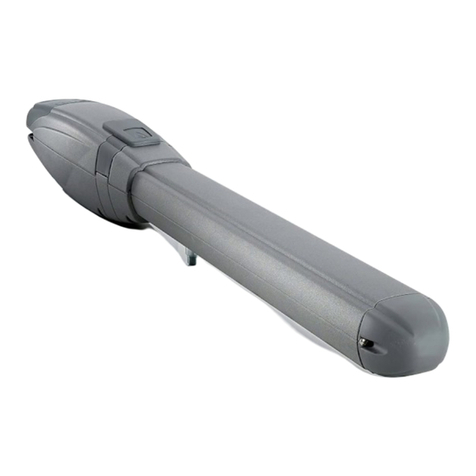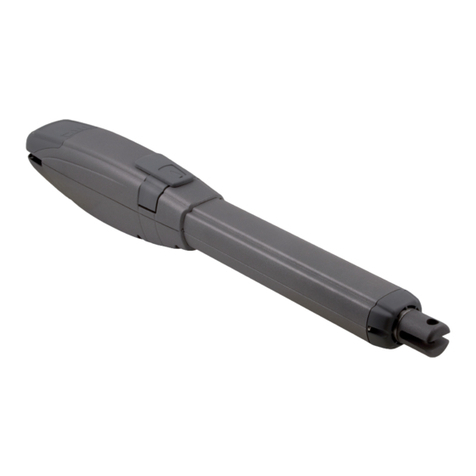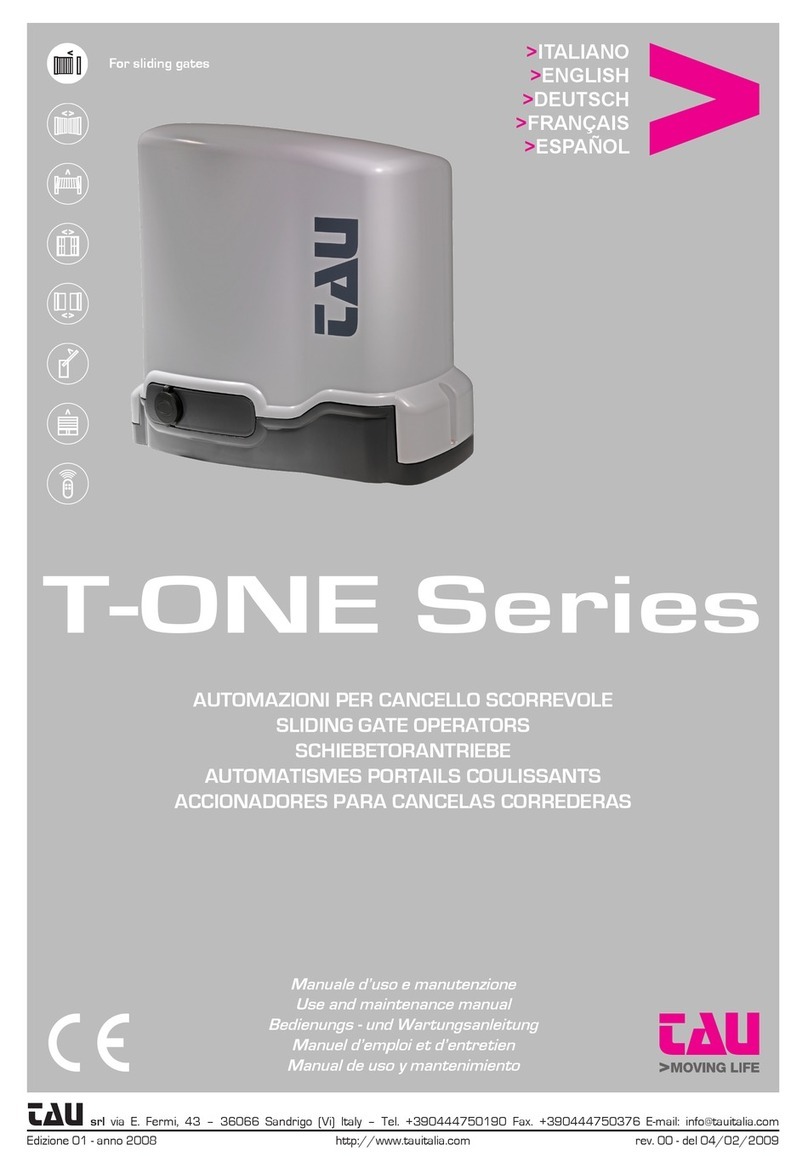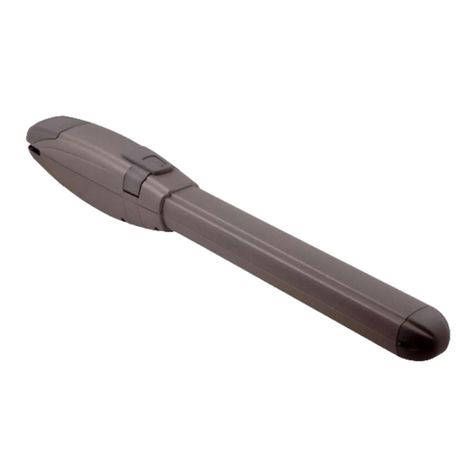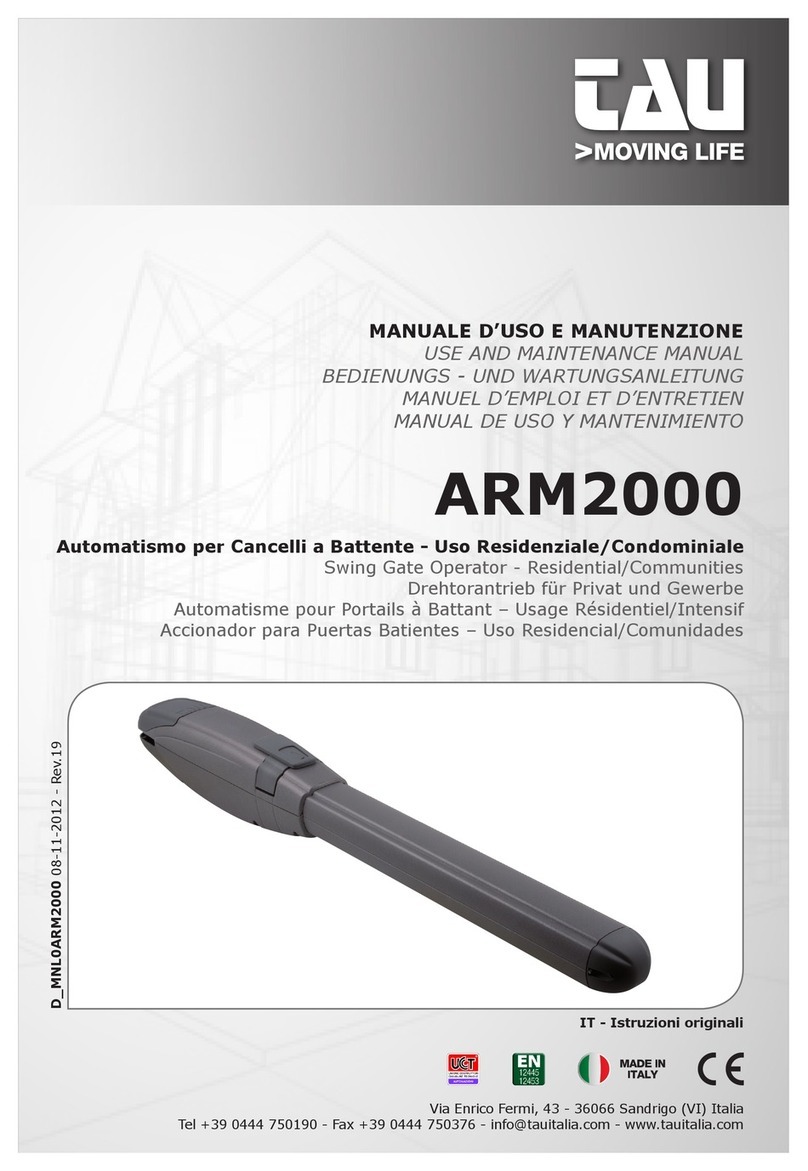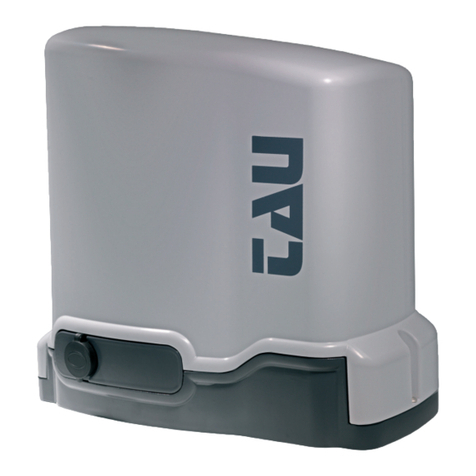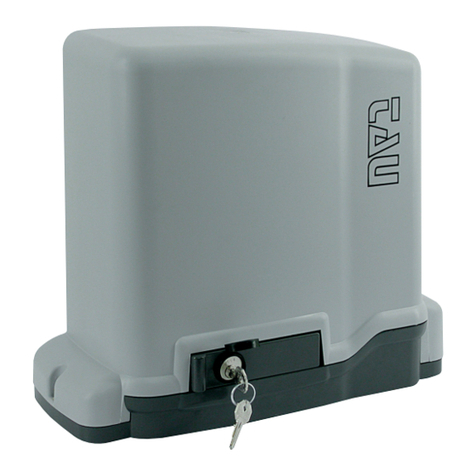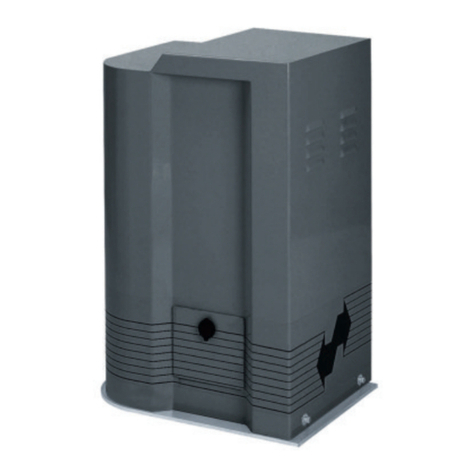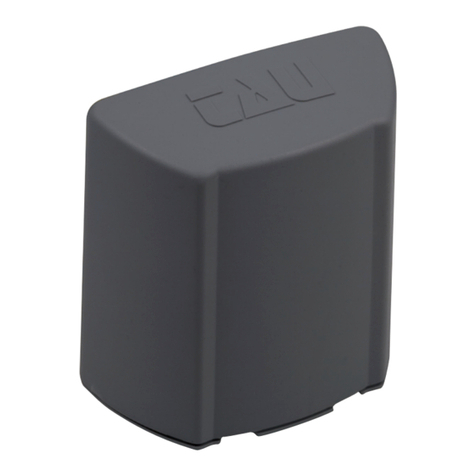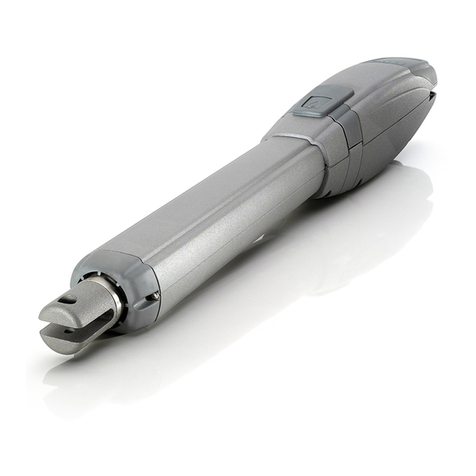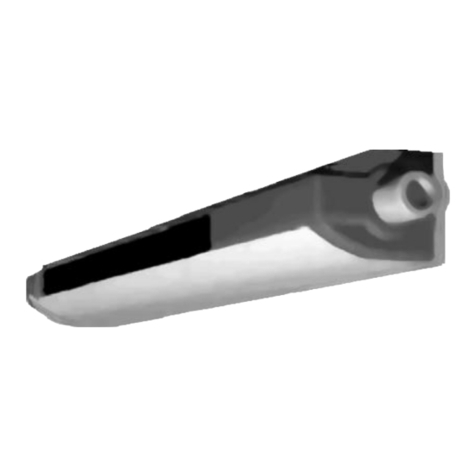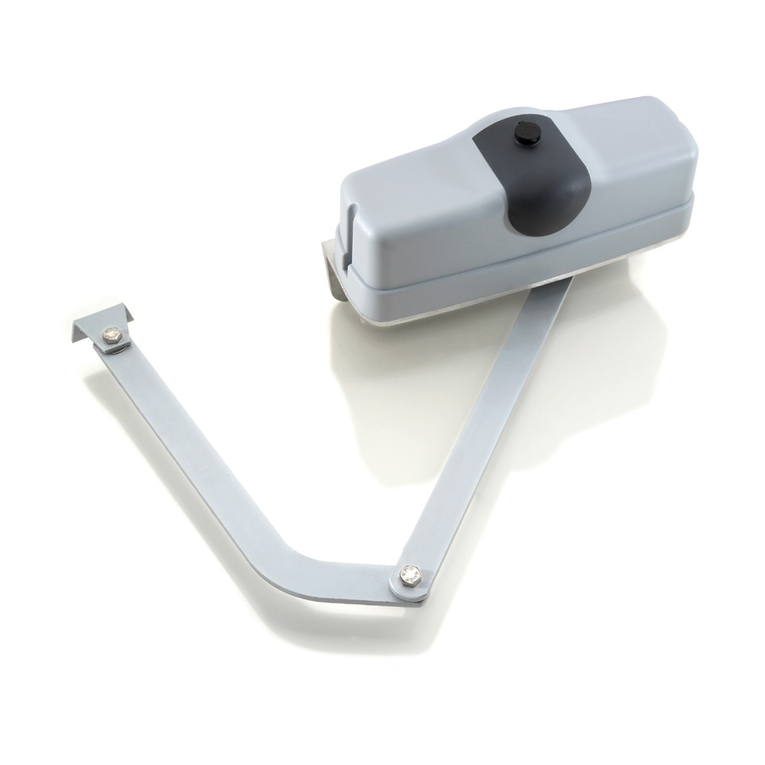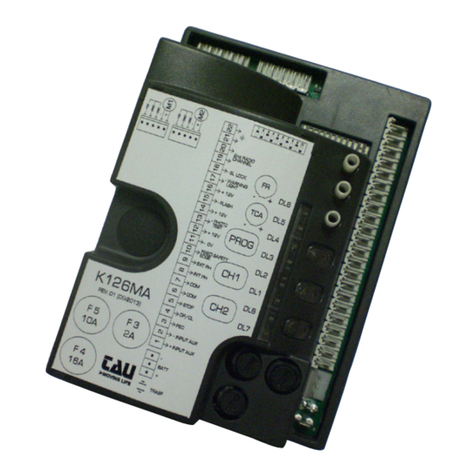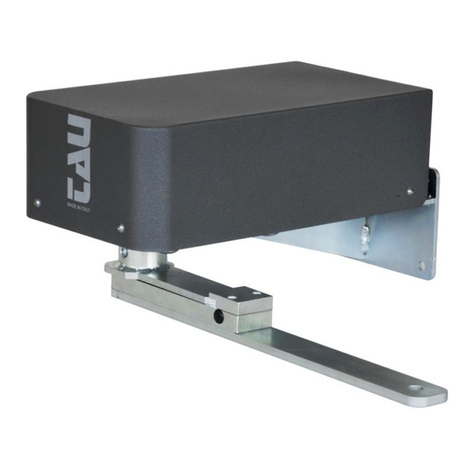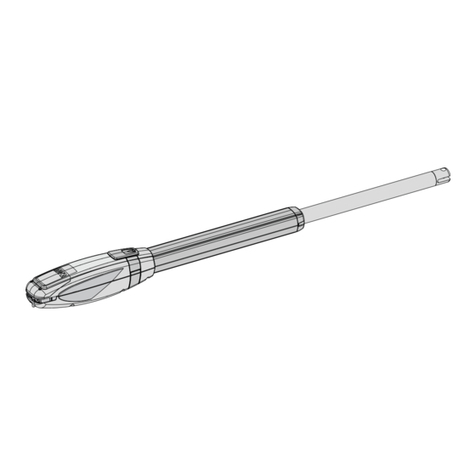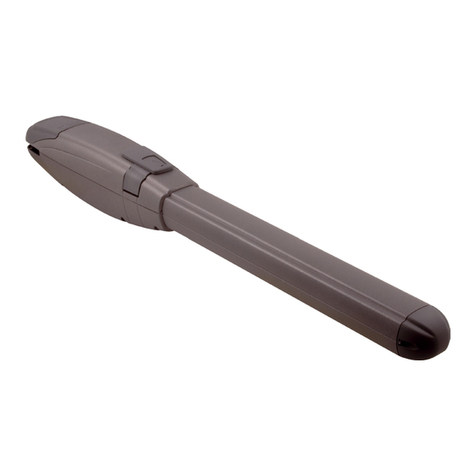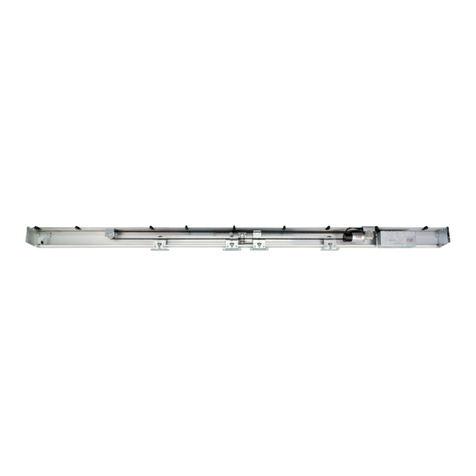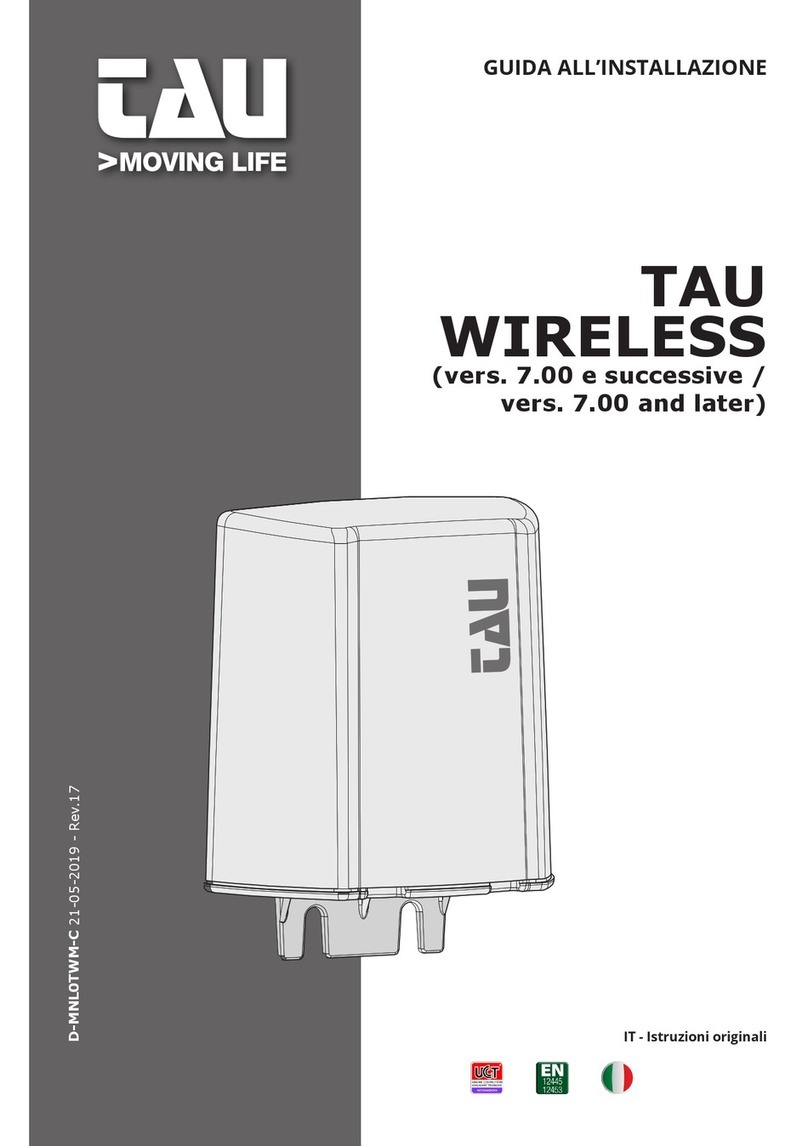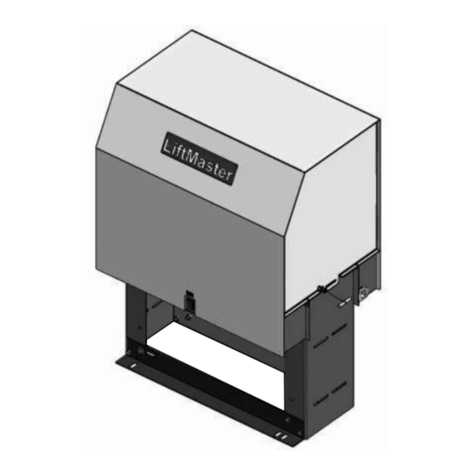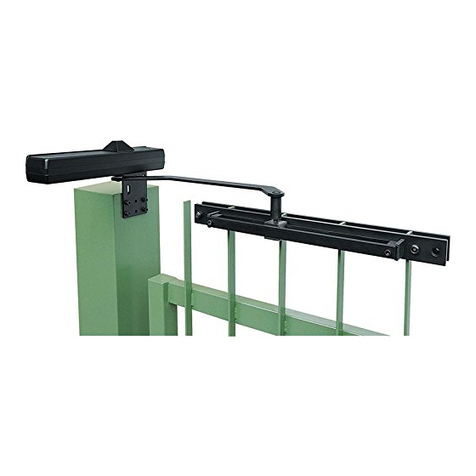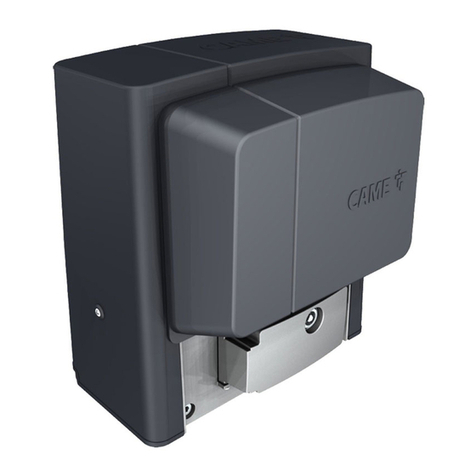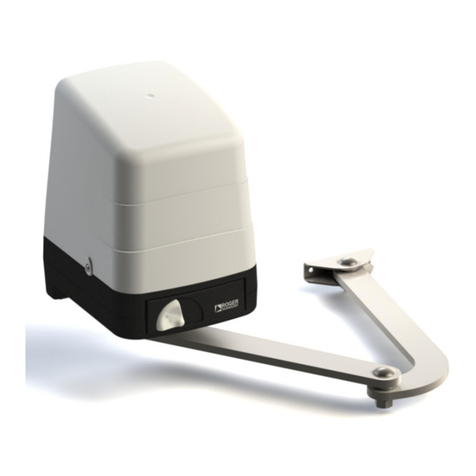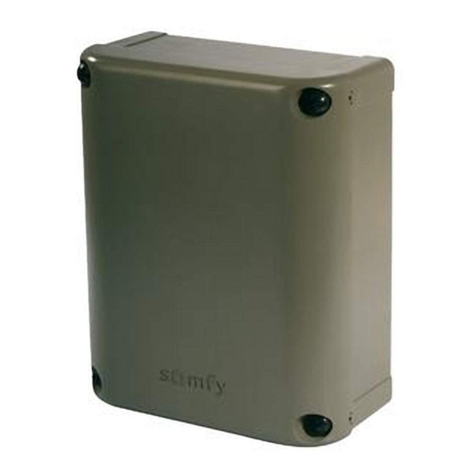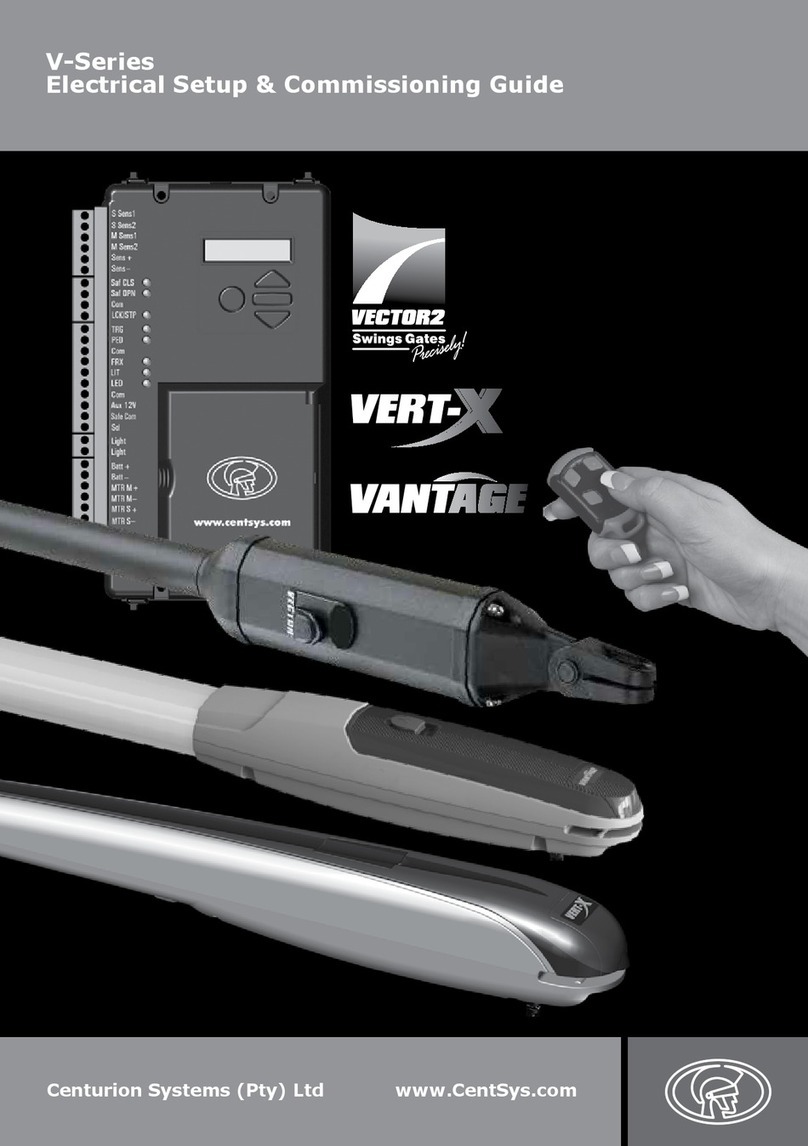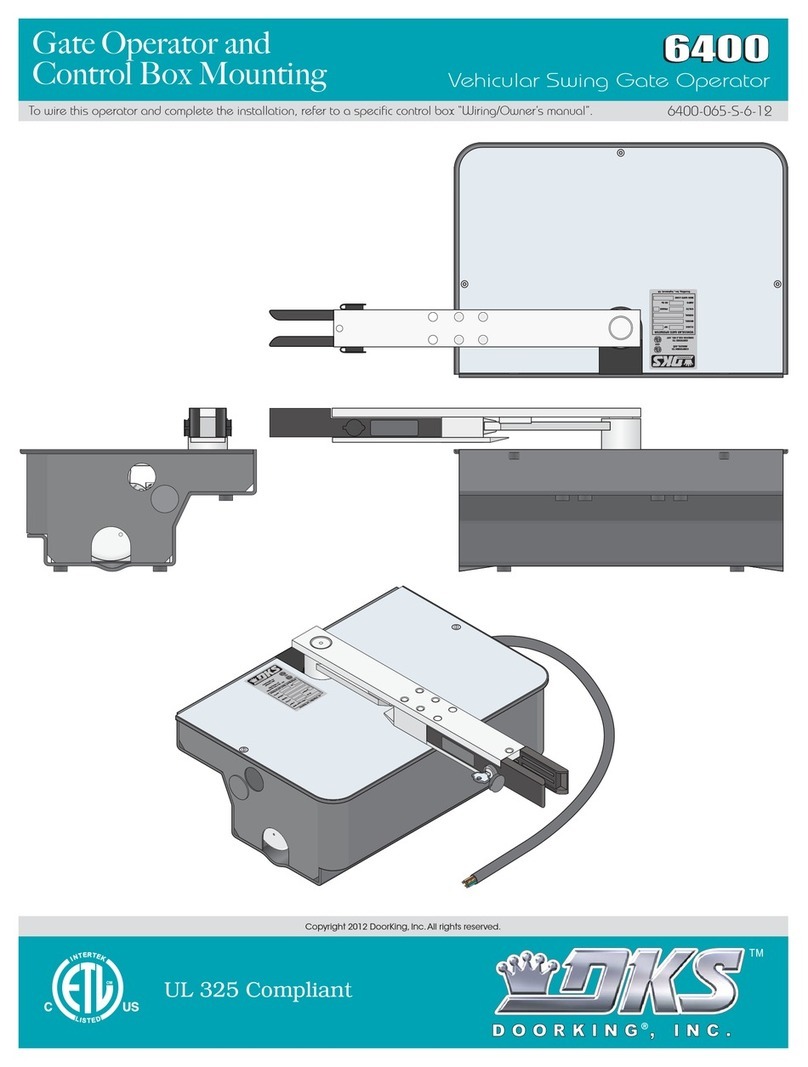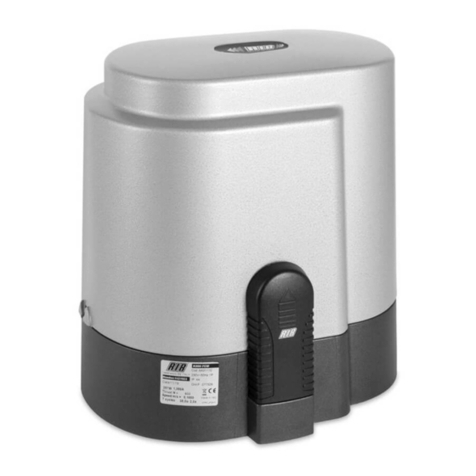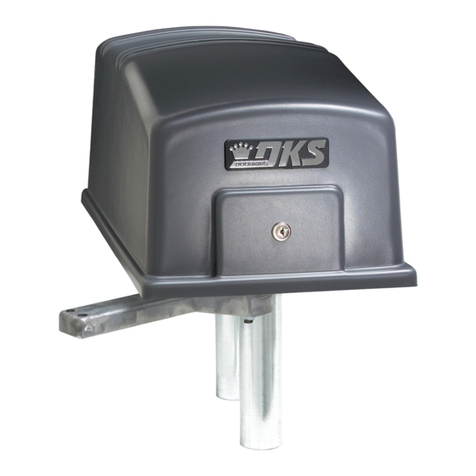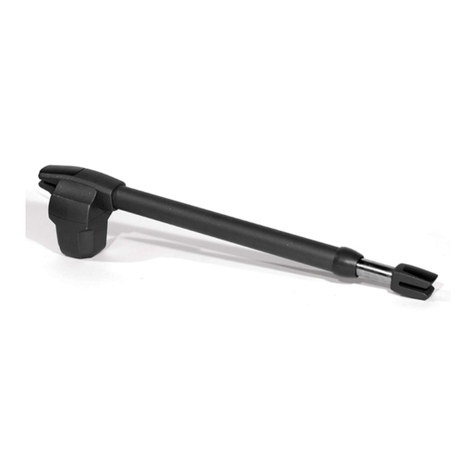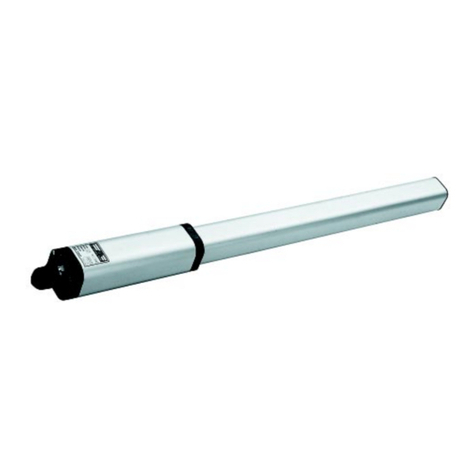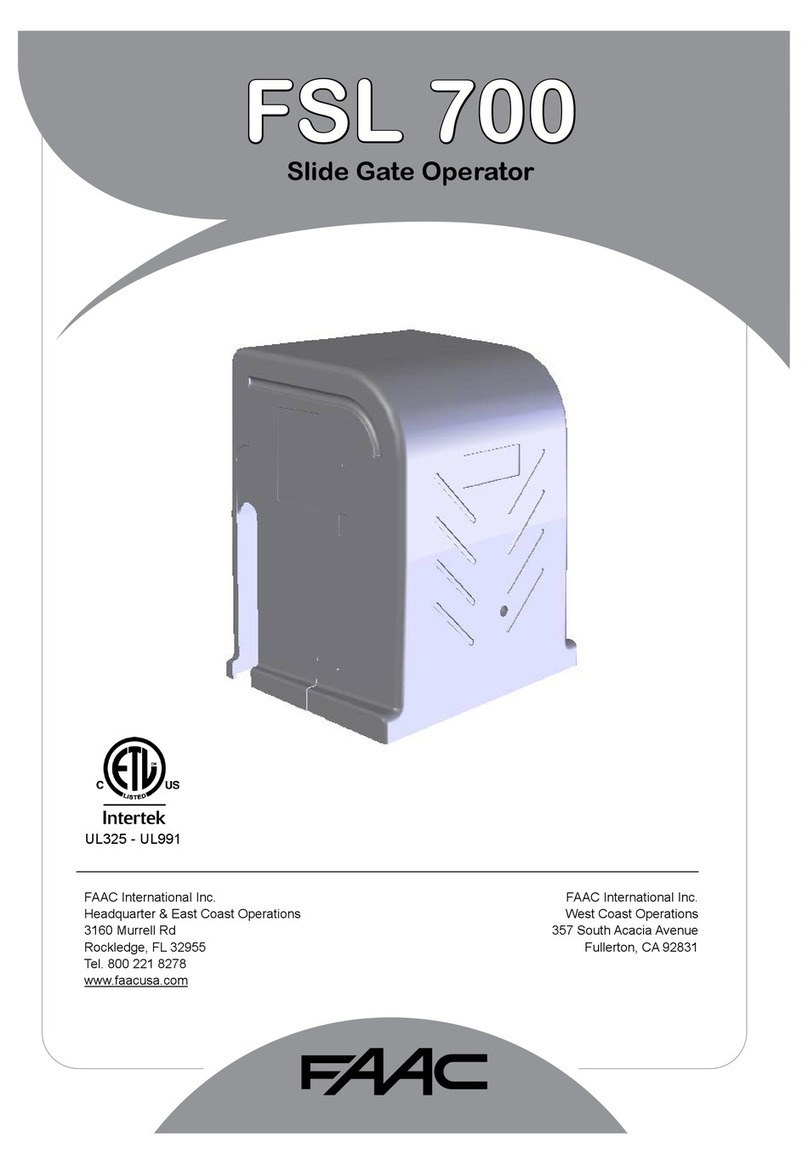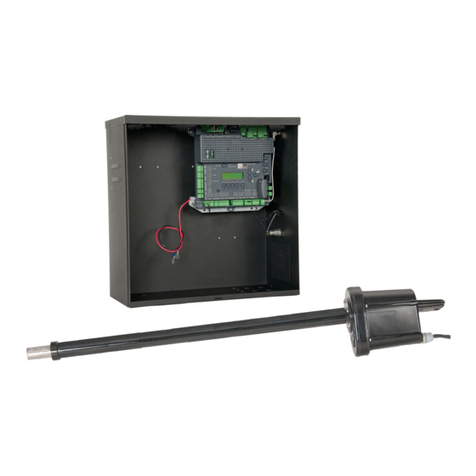tau Easy Series User manual

1
EASY Series
MANUALE D’USO E MANUTENZIONE
USE AND MAINTENANCE MANUAL
BEDIENUNGS - UND WARTUNGSANLEITUNG
MANUEL D’EMPLOI ET D’ENTRETIEN
MANUAL DE USO Y MANTENIMIENTO
EASY
Automatismo per Cancelli a Battente - Uso Residenziale/Condominiale
Swing Gate Operator - Residential/Communities
Drehtorantrieb für Privat und Gewerbe
Automatisme pour Portails à Battant – Usage Résidentiel/Intensif
Accionador para Puertas Batientes – Uso Residencial/Comunidades
Via Enrico Fermi, 43 - 36066 Sandrigo (VI) Italia
Tel +39 0444 750190 - Fax +39 0444 750376 - info@tauitalia.com - www.tauitalia.com
IT - Istruzioni originali
D_MNL0EASY 18-05-2010 - Rev.17

2
EASY Series
Italiano
Español
English
Français
Deutsch
I dati riportati nel presente manuale sono puramente indicativi. La TAU si riserva il diritto di modicarli in qualsiasi momento.
La Casa costruttrice si riserva il diritto di apportare modiche o miglioramenti al prodotto senza alcun preavviso. Eventuali imprecisioni
o errori riscontrabili nel presente fascicolo, saranno corretti nella prossima edizione.
All’apertura dell’imballo vericare che il prodotto sia integro. Riciclare i materiali secondo la normativa vigente.
L’installazione del prodotto dovrà essere effettuata da personale qualicato. La Ditta costruttrice Tau declina ogni responsabilità
per danni derivanti a cose e/o persone dovuti ad un’eventuale errata installazione dell’impianto o la non messa a Norma dello
stesso secondo le vigenti Leggi (vedi Direttiva Macchine).
I disegni esplosi presenti nelle ultime pagine delle presenti istruzioni sono puramente indicativi. Per i ricambi fare riferimento al relativo
listino.
Los datos describidos en este manual son puramente indicativos. La TAU se reserva el derecho de modicarlos en cualquier
momento.
El Fabricante se reserva el derecho de modicar o actualizar el producto sin aviso previo. Posibles imprecisiones o errores en este
manual serán corregidos en la próxima edición.
Cuando abra el embalaje, controle que el producto esté íntegro. Recicle los materiales según la normativa vigente.
La instalación del producto tiene que ser efectuada por personal cualicado. El Fabricante Tau no se asume ninguna
responsabilidad por lesiones a personas o averías a cosas causadas por una instalación incorrecta del equipo o la por la
inobservancia de la normativa vigente (véase Directiva de Máquinas).
Los dibujos estallados que hay en las ultimas paginas de este manual son puramente indicativos. Por los repuestos hay que hacer
referencia a la lista.
The data described in this handbook are purely a guide. TAU reserves the right to change them in any moment.
The manufacturer reserves the right to modify or improve products without prior notice. Any inaccuracies or errors found in this handbook
will be corrected in the next edition.
When opening the packing please check that the product is intact. Please recycle materials in compliance with current regulations.
This product may only be installed by a qualied tter. The manufacturer declines all liability for damage to property and/or
personal injury deriving from the incorrect installation of the system or its non-compliance with current law (see Machinery
Directive).
The exploded views on the last pages of this instruction manual are purely indicative. For the spare parts, please refer to the relevant
price list.
Les données décrites dans ce manual sont purement indicatives. La TAU se réserve le droit de les modier à n’importe quel moment.
Le Constructeur se réserve le droit d’apporter des modications ou des améliorations au produit sans aucun préavis. Les éventuelles
imprécisions ou erreurs présentes dans ce fascicule seront corrigées dans la prochaine édition.
À l’ouverture de l’emballage, vérier que le produit est intact. Recycler les matériaux suivant les normes en vigueur.
L’installation du produit devra être effectuée par du personnel qualié. Tau décline toute responsabilité pour les dommages
aux choses et/ou personnes dus à une éventuelle installation erronée de l’automatisme ou à la non-mise aux normes suivant
les lois en vigueur (voir Directive Machines).
Les plans “esplosi non lo so” qui se trouvent sur les dernières pages de ces notices techniques sont à titre indicatif. En ce qui concerne
les pièces détachées consulter la liste relative.
Die beschriebenen Daten in der vorliegenden Betriebsanleitung sind rein indikativ. TAU behält sich vor, diese in jedem Moment zu
modizieren.
Der Hersteller behält sich das Recht vor, ohne vorherige Benachrichtung Änderungen oder Verbesserungen am Produkt anzubringen.
Ungenauigkeiten oder Fehler, die in der vorliegenden Ausgabe festgestellt werden, werden in der nächsten Ausgabe berichtigt.
Beim Öffnen der Verpackung prüfen, dass das Produkt keine Schäden aufweist. Die Materialien nach den gültigen Vorschriften
recyclen.
Die Installation des Produktes muss von Fachpersonal ausgeführt werden. Die Herstellerrma TAU übernimmt keinerlei
Haftung für Personen- und/oder Sachschäden aufgrund einer falschen Installation der Anlage oder der Nichtkonformität
derselben mit den gültigen Gesetzen (siehe Maschinenrichtlinie).
Die explodierten Zeichnungen auf den letzten Seiten dieser Anleitung sind nur anzeigend. Für die Ersatzteile, bitte die entsprechende
Preisliste sehen.

3
EASY Series
AVVERTENZE E ISTRUZIONI PER L’INSTALLATORE
Tau si congratula per la scelta del prodotto e vi invita a leggere con molta attenzione queste pagine.
Al ne di renderle semplici, le istruzioni sono state impaginate seguendo l’ordine delle varie fasi d’installazione dell’impianto.
Leggere attentamente le istruzioni prima di procedere all’installazione, in quanto forniscono importanti indicazioni concernenti
la sicurezza, l’installazione, l’uso e la manutenzione.
Tutto quello che non è espressamente previsto nel presente manuale NON è permesso. Consultare la TAU srl per ogni cosa non
indicata.
Usi non indicati, infatti, potrebbero essere causa di danni al prodotto stesso e mettere in pericolo persone, animali e/o cose.
L’installazione deve essere eseguita da personale qualicato, professionalmente competente.
L’installazione, i collegamenti elettrici e le regolazioni devono essere effettuati nell’osservanza della Buona Tecnica e in ottemperanza alle
norme vigenti.
Prima di iniziare l’installazione vericare l’integrità del prodotto.
Non installare il prodotto in ambiente e atmosfera esplosivi.
Prima di installare l’automazione, apportare tutte le modiche strutturali relative alla realizzazione dei franchi di sicurezza ed alla protezione
o segregazione di tutte le zone di schiacciamento, cesoiamento, convogliamento e di pericolo in genere. Vericare che la struttura esistente
abbia i necessari criteri di robustezza e stabilità. Per la messa a punto della coppia massima del motoriduttore, attenersi alle normative in
vigore (per l’Europa consultare le norme prEN 12341 e prEN 12635).
L’installazione del motoriduttore, ad eccezione dei modelli interrati, deve essere realizzata sopra il livello del pavimento, al ne di evitare
rischi di allagamento.
I dispositivi di sicurezza (fotocellule, coste sensibili, stop di emergenza, ecc.) devono essere installati tenendo in considerazione: le
normative e le direttive in vigore, i criteri della Buona Tecnica, l’ambiente di installazione, la logica di funzionamento del sistema e le forze
sviluppate dalla porta o cancello motorizzati.
Scegliere percorsi brevi per i cavi. Tenere separati i cavi di potenza dai cavi di comando.
Quantunque il motoriduttore possa essere dotato di tutti i dispositivi di sicurezza si consiglia caldamente di tenere fuori della portata di
bambini o di persone inabili ogni dispositivo in grado di comandare l’apertura del cancello e che possa inavvertitamente essere usato
senza sorveglianza.
Applicare le segnalazioni previste dalle norme vigenti per individuare le zone pericolose. Ogni installazione deve riportare in modo visibile
l’indicazione dei dati identicativi degli organi automatizzati.
Prima di collegare l’alimentazione elettrica accertarsi che i dati di targa siano rispondenti a quelli della rete di distribuzione elettrica.
Prevedere sulla rete di alimentazione un interruttore/sezionatore onnipolare con distanza d’apertura dei contatti uguale o superiore a 3
mm.
Vericare che a monte dell’impianto elettrico vi siano un interruttore differenziale e una protezione di sovracorrente adeguati (interruttore
magnetotermico C6).
Collegare l’automazione ad un efcace impianto di messa a terra eseguito come previsto dalle vigenti norme di sicurezza.
Il costruttore dell’automazione declina ogni responsabilità qualora vengano installati elementi incompatibili ai ni della sicurezza e del buon
funzionamento. Per l’eventuale riparazione o sostituzione dei prodotti, dovranno essere utilizzati esclusivamente ricambi originali.
L’installatore deve fornire tutte le informazioni relative al funzionamento automatico, manuale e di emergenza della struttura automatizzata,
e consegnare all’utilizzatore dell’impianto le istruzioni per l’uso.
Consigliamo di riporre tutta la documentazione relativa all’impianto all’interno o nelle immediate vicinanze della centralina.
WARNINGS AND INSTRUCTIONS FOR FITTERS
Congratulations on choosing this Tau product. Please read this handbook carefully.
For the sake of simplicity, the instructions are listed in order of installation.
Please read these instructions carefully before installing the product as they contain important information concerning safety,
installation, use and maintenance.
Anything not expressly specied in this handbook is FORBIDDEN. Contact TAU srl for information regarding any points which may not
have been specied in the present manual.
Operations not indicated in these instructions may damage the product and put people, animals and/or and property at risk.
The equipment should be installed only by trained and qualied personnel.
Installation, electrical connections and adjustments must be made according to the rules of good workmanship and current standards.
Before beginning installation, make sure the product is undamaged.
Do not install the product in explosive environments.
Prior to installing the automation, make all structural modications in order to ensure safety distances and protect and segregate areas
in which people may be exposed to the risk of crushing, shearing, dragging or similar dangers. Make sure the existing structure is
sufciently sturdy and stable. Observe current legislation when adjusting maximum gearmotor torque (in Europe consult prEN 12341
and prEN 12635 standards).
Apart from buried models, the gearmotor must be installed above ground level in order to prevent damage deriving from ooding.
The safety devices (photocells, sensitive edges, emergency stop devices, etc.) must be installed according to current legislation and
directives, the rules of good workmanship, the installation area, the operating logic of the system and the forces developed by the
powered door or gate.
Choose short routes for the cables. Keep power cables separate from control cables.
Though the gearmotor is tted with various safety devices, we strongly recommend keeping all unattended devices capable of opening
the gate out of the reach of children or unable adults.
Fit the signs required by current regulations for identifying dangerous areas. Each installation must show the identication data of the
automated devices in a visible place.
Before connecting to the power supply, make sure the data on the rating plate correspond to the mains power supply.
Fit a multipole switch/knife switch on the power supply network with contacts opening distance of at least 3 mm.
Make sure there is a suitable circuit breaker and overcurrent protection device (thermal-magnet breaker C6) upline from the electrical
system.
Connect the automation to an efcient earth system compliant with current safety standards.
The manufacturer declines all liability if incompatible safety and components are installed. Only use original spare parts to repair or
replace the product.
The tter must provide all the information relative to the automatic, manual and emergency operation of the automated unit, and give
the user the operating instructions.
Keep all the documents concerning the system inside or near the central control unit.
Italiano
English

4
EASY Series
AVERTISSEMENTS ET INSTRUCTIONS POUR L’INSTALLATEUR
Tau vous félicite de votre choix et vous invite à lire très attentivement les pages qui suivent.
An de faciliter la compréhension, l’ordre de présentation des instructions suit celui des différentes phases d’installation de l’automatisme.
Lire attentivement les instructions avant de procéder à l’installation, dans la mesure où elles fournissent des indications importantes
concernant la sécurité, l’installation, l’emploi et la maintenance.
Tout ce qui n’est pas expressément prévu dans ce manuel N’EST PAS permis. Consulter TAU srl pour tout ce qui n’est pas indiqué.
Les utilisations non indiquées, en effet, pourraient provoquer des dommages au produit et mettre en danger les personnes, les animaux et/ou
les choses.
L’installation doit être effectuée par du personnel qualié, professionnellement compétent.
L’installation, les connexions électriques et les réglages doivent être effectués dans les règles de l’art en respectant les normes en vigueur.
Avant de commencer l’installation, vérier l’intégrité du produit.
Ne pas installer le produit dans un environnement et une atmosphère explosifs.
Avant d’installer l’automatisme, apporter toutes les modications structurelles relatives à la réalisation des espaces de sécurité et à la
protection ou à l’isolement de toutes les zones d’écrasement, cisaillement et de danger en général. Vérier que la structure existante possède
la robustesse et la stabilité nécessaires.
Pour le réglage du couple maximum du motoréducteur, respecter les normes en vigueur (pour
l’Europe consulter les normes prEN 12341 et prEN 12635).
L’installation du motoréducteur, à l’exception des modèles enterrés, doit être réalisée au-dessus du niveau du sol an d’éviter les
risques d’inondation.
Les dispositifs de sécurité (photocellules, barres palpeuses, arrêt d’urgence, etc.) doivent être installés en tenant compte : des normes et des
directives en vigueur, des règles de l’art, du site d’installation, de la logique de fonctionnement du système et des forces générées par la porte
ou le portail motorisés.
Choisir des parcours brefs pour les câbles et maintenir les câbles de puissance séparés des câbles de commande.
Malgré tous les dispositifs de sécurité qui peuvent équiper l’automatisme, il est vivement conseillé de maintenir hors de portée des
enfants ou de personnes inaptes tout dispositif en mesure de commander l’ouverture du portail et qui, par mégarde, pourrait être
utilisé sans surveillance.
Appliquer les signalisations prévues par les normes en vigueur pour identier les zones dangereuses. Chaque installation doit reporter de
manière visible, l’indication des données d’identication des organes automatisés.
Avant de connecter l’alimentation électrique, s’assurer que les données de la plaque correspondent à celles du secteur de distribution électrique.
Prévoir sur le secteur d’alimentation un interrupteur/sectionneur omnipolaire avec distance d’ouverture des contacts égale ou supérieure à 3
mm.
Vérier qu’il y a en amont de l’automatisme un interrupteur différentiel et une protection contre la surcharge adéquats (interrupteur
magnétothermique C6).
Raccorder l’automatisme à une installation efcace de mise à la terre effectuée suivant les prescriptions des normes de sécurité en vigueur.
Le constructeur de l’automatisme décline toute responsabilité en cas d’installation de composants incompatibles en matière de sécurité et de
bon fonctionnement. Pour toute réparation ou pour tout remplacement des produits, il faudra utiliser exclusivement des pièces de rechange
originales.
L’installateur doit fournir toutes les informations relatives au fonctionnement automatique, manuel et d’urgence de la structure automatisée et
remettre à l’utilisateur de l’automatisme le mode d’emploi.
Nous conseillons de conserver toute la documentation relative à l’installation à l’intérieur de l’armoire de commande ou à proximité
immédiate.
HINWEISE UND ANWEISUNGEN FÜR DEN INSTALLATEUR
Tau gratuliert Ihnen zur Wahl dieses Produkts und bittet Sie, diese Seiten sehr aufmerksam zu lesen.
Um die Anweisungen einfach zu machen, wurden sie in der Reihenfolge der verschiedenen Installationsphasen der Anlage verfasst.
Die Anweisungen vor der Installation genau lesen, da sie wichtige Hinweise mit Bezug auf Sicherheit, Installation, Bedienung und
Wartung liefern.
Alles nicht ausdrücklich in diesen Anleitungen vorgesehene ist UNZULÄSSIG. Wenden Sie sich für alles nicht angegebene an die Firma TAU
srl.
Ein nicht angegebener Gebrauch könnte Schäden am Produkt verursachen und Personen, Tiere und/oder Gegenstände in Gefahr bringen.
Die Installation muss von beruich kompetentem Fachpersonal ausgeführt werden.
Installation, elektrische Anschlüsse und Einstellungen sind unter Beachtung der Fachtechnik und der gültigen Vorschriften auszuführen.
Das Produkt vor der Installation auf Schäden überprüfen.
Das Produkt nicht in EX-Umgebung bzw. EX-Atmosphäre installieren.
Vor der Installation der Automatisierung alle strukturellen Änderungen für das Vorhandensein der Sicherheitsabstände und den Schutz aller
Bereiche ausführen, in denen Quetsch-, Schnitt- und Mitnehmgefahr und Gefahren allgemein bestehen. Prüfen, ob die vorhandene Struktur
die erforderliche Robustheit und Stabilität besitzt.
Für die Einstellung des maximalen Drehmoments des Getriebemotors sind die gültigen
Vorschriften zu beachten (für Europa siehe die Normen prEN 12341 und prEN 12635).
Die Installation des Getriebemotors muss, Unterurmodelle ausgenommen, über der Bodenhöhe erfolgen, um Überschwemmungsgefahr
zu vermeiden.
Sicherheitsvorrichtungen (Fotozellen, Sicherheitsleisten, Notstop usw.) müssen unter Berücksichtigung des folgenden installiert werden: gültige
Vorschriften und Verordnungen, korrekte Fachtechnik, Installationsumgebung, Betriebslogik des Systems und Kräfte, die vom motorbetriebenen
Tor entwickelt werden.
Kurze Strecken beim Verlegen der Kabel wählen. Leistungskabel von Steuerkabeln getrennt halten.
Auch wenn der Getriebemotor mit allen Sicherheitsvorrichtungen ausgestattet werden kann, empfehlen wir, Vorrichtungen zur Betätigung
eines Tors, die ohne Überwachung zufällig benutzt werden könnten, außer der Reichweite von Kindern oder Personen mit Handicaps
zu halten.
Zur Kennzeichnung von Gefahrenbereichen die laut gültigen Vorschriften vorgesehenen Beschilderungen anbringen. An jeder Installation
müssen die Kenndaten der automatisierten Elemente sichtbar angegeben sein.
Vor dem Anschluss der Stromversorgung ist sicher zu stellen, dass die Kenndaten mit jenen des Stromnetzes übereinstimmen.
Am Versorgungsnetz einen allpoligen Schalter/Trennschalter mit Öffnungsabstand der Kontakte von oder über 3 mm vorsehen.
Prüfen, dass vor der elektrischen Anlage ein Differentialschalter und ein geeigneter Überstromschutz (magnetothermischer Schalter C6)
vorhanden sind.
Die Automatisierung an eine wirksame Erdungsanlage anschließen, die nach den gültigen Sicherheitsvorschriften ausgeführt ist.
Der Hersteller der Automatisierung übernimmt keinerlei Haftung, falls Bestandteile installiert werden, die – was Sicherheit und korrekten Betrieb
betrifft – nicht kompatibel sind. Zur Reparatur oder zum Ersatz der Produkte dürfen ausschließlich Originalersatzteile verwendet werden.
Der Installateur hat alle Auskünfte über den automatischen und manuellen Betrieb und den Notbetrieb der automatisierten Struktur zu liefern
und muss dem Benutzer der Anlage die Bedienungsanweisungen aushändigen.
Wir empfehlen, alle Unterlagen der Anlage in der Steuerzentrale oder in ihrer unmittelbaren Nähe aufzubewahren.
Français
Deutsch

5
EASY Series
ADVERTENCIAS E INSTRUCCIONES PARA EL INSTALADOR
Tau le agradece por la elección del producto y le invita a leer con mucha atención estas páginas.
A n de simplicar su uso, las instrucciones han sido compaginadas siguiendo el orden de las diferentes etapas de instalación del sistema.
Lea con atención las instrucciones antes de proceder con la instalación, puesto que suministran importantes indicaciones sobre la
seguridad, instalación, uso y mantenimiento.
Todo aquello que no está expresamente previsto en este manual NO está permitido. Consulte con TAU srl para cualquier cosa que no esté
indicada.
En efecto, los usos no previstos podrían causar averías al producto y ser peligrosos para las personas, animales o cosas.
La instalación debe ser hecha por personal cualicado y experto.
La instalación, las conexiones eléctricas y las regulaciones deben ser efectuadas correctamente y respetando las normas vigentes.
Antes de empezar la instalación, controle la integridad del producto.
No instale el producto en locales con atmósfera explosiva.
Antes de instalar la automatización, realice todas las modicaciones estructurales relativas a la realización de las distancias de seguridad y
a la protección o separación de todas las zonas de aplastamiento, corte y peligro en general. Controle que la estructura existente posea los
criterios necesarios de robustez y estabilidad.
Para poner a punto el par máximo del motorreductor, aténgase a las normativas en vigor
(para Europa consulte las normas prEN 12341 y prEN 12635).
La instalación del motorreductor, menos en el caso de los modelos enterrados, tiene que efectuarse por encima del nivel del
pavimento para evitar posibles inundaciones.
Los dispositivos de seguridad (fotocélulas, bordes sensibles, botón de parada de emergencia, etc.) se deben instalar teniendo en cuenta:
las normativas y directivas vigentes, los criterios de la buena técnica, el entorno de instalación, la lógica de funcionamiento del sistema y las
fuerzas desarrolladas por la puerta o cancela motorizadas.
Escoja recorridos cortos para los cables. Mantenga separados los cables de potencia de los cables de control.
Aunque el motorreductor disponga de todos los dispositivos de seguridad, se aconseja mantener fuera del alcance de los niños o de
personas incapacitadas cualquier dispositivo capaz de controlar la apertura de la cancela y que pueda utilizarse de forma inadvertida
sin vigilancia.
Aplique las señalizaciones previstas por las normas vigentes para señalar las zonas peligrosas. Cada instalación debe tener a la vista la
indicación de los datos de identicación de los componentes automatizados.
Antes de conectar la alimentación eléctrica, controle que las características nominales correspondan a aquellas de la red de distribución
eléctrica.
Prevea en la red de alimentación un interruptor omnipolar de 3 o más mm de apertura de los contactos.
Controle que antes de la instalación eléctrica haya un interruptor diferencial y un dispositivo de protección de sobrecorriente adecuados
(interruptor magnetotérmico C6).
Conecte la automatización a una instalación de puesta a tierra ecaz y que respete las normas de seguridad vigentes.
El fabricante de la automatización no se asume ninguna responsabilidad si se instalan componentes incompatibles para la seguridad y el
funcionamiento correcto. Para una posible reparación o sustitución de los productos, use sólo recambios originales.
El instalador debe suministrar todas las informaciones relativas al funcionamiento automático, manual y de emergencia de la estructura
automatizada, y entregar al usuario de la instalación las instrucciones para su uso.
Se aconseja guardar toda la documentación de la instalación en el interior o cerca de la central.
Español
INDICE - INHALTSVERZEICHNIS - CONTENTS - INDEX – ÍNDICE
pag. 6 Caratteristiche tecniche della serie ARM200 - Technische Eigenschaften der serie ARM200 - Technical features of the
ARM200 series - Caractéristiques techinques de la série ARM200 - Características técnicas de la serie ARM200.
pag. 7 Italiano
pag. 10 English
pag. 13 Deutsch
pag. 16 Français
pag. 17 Disegni - Drawings - Zeichnen - Projets - Dibujos
pag. 23 Español
pag. 26 Accessori opzionali - Optional accessories - Sonderzubehör - Accessoires en option - Accesorios opcionales
pag. 28 Esplosi della serie ARM200 - Exploded diagrams of the ARM200 series - Explosionszeichnungen der reihe ARM200 - Vues
éclatées de la série ARM200 - Despieces de la serie ARM200
pag. 35 Garanzia - Garantie - Guarantee - Garantie - Garantía

6
EASY Series
CARATTERISTICHE TECNICHE
TECHNICAL FEATURES
TECHNISCHE MERKMALE
CARACTÉRISTIQUES TECHNIQUES
CARACTERÍSTICAS TÉCNICAS
EASY EASYQR EASY 12
Alimentazione \ Power input \ Versorgung \ Alimentation \ Alimentación 230 Vac
Alimentazione Motore \ Motor power input \ Motorversorgung \ Alimentation Moteur \ Alimentación
motor 230 Vac 19 Vdc
Frequenza \ Frequency \ Frequenz \ Fréquence \ Frecuencia 50/60 Hz
Condensatore \ Capacitor \ Kondensator \ Condensateur \ Condensador 12,5 µf -
Corrente assorbita a vuoto \ Absorbed current (no load) \ Stromaufnahme (ohne Last) \ Courant
absorbé (à vide) \ Corriente absorbida (en vacío) 1,5 A ± 10% 0,7 A ± 10%
Potenza assorbita a vuoto \ Absorbed power (no load) \ Leistungsaufnahme (ohne Last) \
Puissance absorbée (à vide) \ Potencia absorbida (en vacío) 250 W 20 W
Velocità motore (a vuoto) \ Motordrehzahl (leer) \ Motor speed (no load) \ Vitesse moteur (à vide)
\ Velocidad motor (en vacío) 900 rpm 1200 rpm
Coppia \ Torque \ Drehmoment \ Couple \ Par 160 Nm 210 Nm 150 Nm
Intervento di termoprotezione \ Thermal protection trips at \ Auslösung des Wärmeschutzes \
Intervention protection thermique \ Intervención de termoprotección 140 °C (autoripristino) -
Rapporto di riduzione \ Reduction ratio \ Untersetzungsverhältnis \ Rapport de réduction \
Relación de reducción 1/720
Temperatura di esercizio \ Operating temperature \ Betriebstemperatur \ Température de
fonctionnement \ Temperatura de ejercicio Da –20 °C a +70 °C
Peso \ Weight \ Gewicht \ Poids \ Peso 8,9 Kg 9,1 Kg 6,5 Kg
IP Motore \ Motor IP \ Schutzart des Motors (IP) \ IP Moteur \ IP Motor IP 43
Ciclo di lavoro \ Work cycle \ Arbeitzzyklus \ Cycle de travail \ Ciclo de trabajo 15 % 100 %
Tempo corsa 90° \ 90° travel time \ Laufzeit, 90° \ Temps de course 90° \ Tiempo recorrido 90° 14,3 sec. 11 sec.
N.B.: Per impianti con ante superiori a 2,3 mt è consigliabile l’applicazione di un’elettroserratura per una maggiore tenuta in
chiusura. L’installatore deve inoltre vericare che sul cancello sia possibile l’installazione di tale dispositivo.
NOTA: QUANDO IL SISTEMA IN 12 VDC È ALIMENTATO UNICAMENTE DALLA BATTERIA (IN CASO DI BLACK-OUT OPPURE
IN ABBINAMENTO CON PANNELLO FOTOVOLTAICO), LE PRESTAZIONI ESPRESSE DAL MOTORIDUTTORE (FORZA E
VELOCITÀ) SI RIDUCONO DEL 30% CA.
N.B.: An electronic lock should be tted to ensure a rmer closure on systems with leaves over 2.3 m. The tter should also
check that the gate can be tted with such a device.
N.B. WHEN THE SYSTEM IS IN THE 12 V DC MODE AND IS POWERED BY THE BATTERY ONLY (IN THE EVENT OF A POWER
FAILURE OR WHEN USED IN CONJUNCTION WITH A PHOTOVOLTAIC PANEL), THE GEAR MOTOR’S OUTPUT (POWER AND
SPEED) IS REDUCED BY APPROXIMATELY 30% .
BITTE BEMERKEN: Für Anlagen mit Torügeln über 2,3 m wird die Anbringung eines Elektroschlosses für einen besseren Halt
in Schließung empfohlen. Der Installateur hat zu prüfen, ob die Montage einer solche Vorrichtung am Tor möglich ist.
ANMERKUNG: WENN DAS 12 VDC SYSTEM NUR ÜBER BATTERIE GESPEIST IST (BEI STROMAUSFALL ODER IN
KOMBINATION MIT EINEM PHOTOVOLTAICPANEEL), VERRINGERN SICH DIE LEISTUNGEN DES GETRIEBEMOTORS (KRAFT
UND GESCHWINDIGKEIT) UM CA. 30%.
N.B.: Pour les installations avec battants supérieurs à 2,3 m, il est conseillé d’appliquer une serrure électrique pour un blocage
plus sûr en fermeture. L’installateur devra vérié en outre qu’il est possible d’installer ce dispositif sur le portail.
ATTENTION : QUAND LE SYSTÈME À 12 VCC EST ALIMENTÉ UNIQUEMENT PAR LA BATTERIE (EN CAS DE COUPURE DE
COURANT OU BIEN EN ASSOCIATION AVEC UN PANNEAU PHOTOVOLTAÏQUE), LES PERFORMANCES DU MOTORÉDUCTEUR
(FORCE ET VITESSE) DIMINUENT D’ENVIRON 30% .
N.B.: Para instalaciones con hojas de más de 2,3 m se aconseja aplicar una electrocerradura para obtener mayor resistencia
en el cierre. El instalador tiene que vericar que sea posible instalar este dispositivo en la cancela.
NOTA: CUANDO EL SISTEMA DE 12 VDC ES ALIMENTADO ÚNICAMENTE POR LA BATERÍA (EN CASO DE CORTE DE
CORRIENTE, O BIEN COMBINADO CON PANEL FOTOVOLTAICO), LAS PRESTACIONES DEL MOTORREDUCTOR (FUERZA Y
VELOCIDAD) SE REDUCEN EN UN 30%.
Peso anta (Kg)
Weight of leaf (Kg)
Torügelgeweicht (Kg)
Poids battant (Kg)
Peso de la hoja (Kg)
100
150
200
250
300
350
0
1,00 1,50 2,00 2,30
300 Kg
250 Kg
215 Kg 200 Kg
N.B.: In presenza di vento, per l’installazione su cancelli ad ante battenti
cieche, non è garantito il funzionamento.
N.B.: For The installation of blank swing gates, functioning cannot be
gua-ranteed in the presence of wind.
N.B.: Bei Wind wird für die Installation an durchgehenden Flügel-toren
der Betrieb nicht garantiert.
N.B.: En présence de vent, en cas d’installation sur des portails avec
portes battantes pleines, le fonctionnement n’est pas garanti.
N.B.: En presencia de viento, para la insta-lación en cancelas de hojas
batientes ciegas, no se garantiza el funcionamiento.
Lunghezza anta (m)
Lenght of leaf (m)
Torügellänge (m)
Longueur battant (m)
Longitud de la hoja (m)

7
EASY Series
DIMENSIONI MOTORIDUTTORE E LIMITI D’IMPIEGO
(g. 1)
VERIFICHE PRELIMINARI
- Leggere attentamente le istruzioni.
- Prima di passare all’installazione, accertarsi che la struttura del
cancello sia solida ed appropriata.
- Accertarsi che il cancello, in tutta la lunghezza della sua corsa,
non subisca punti di attrito.
Nota: per una completa sicurezza si fa obbligo di installare,
se non presenti, i fermi meccanici (battenti a pavimento) con
tappo in gomma in apertura e in chiusura, come mostrato
nelle gg. 24-25.
APPLICAZIONE PIASTRA E STAFFA DI FISSAGGIO
- Fissare la piastra di ssaggio motore al pilastro (g. 3), ad una
distanza minima di 100 mm. dal livello del pavimento (g. 4).
- Fissare (o saldare) la staffa di aggancio braccio snodato all’anta
del cancello (g. 3) rispettando le quote indicate (g. 4).
INSTALLAZIONE
Togliere le due viti autolettanti (g. 5).
Rimuovere il coperchio tirandolo verso l’alto (g. 6).
Inserire il motoriduttore nella piastra di ssaggio in corrispondenza
dei 4 fori e ssarlo con le due viti e relativi dadi in dotazione (g.
7).
APPLICAZIONE DEL BRACCIO SNODATO
Inserire il braccio diritto nell’albero d’uscita del motoriduttore e
ssarlo con la spina, la vite e relativa rosetta. Unire e ssare i due
bracci come da g. 9. Sbloccare il motoriduttore (girare in senso
antiorario la chiave e ruotare la leva di sblocco verso l’esterno -
g. 8). Fissare il braccio curvo alla staffa applicata sull’anta del
cancello con la vite ed il relativo dado in dotazione, vericandone il
libero scorrimento. Per applicazione a destra vedere g. 10.
REGOLAZIONE MICROINTERRUTTORI (EASY -
EASYQR) DI STOP IN CHIUSURA E APERTURA
Regolazioni dei microinterruttori con motoriduttore installato a
sinistra (vista interna).
In apertura: sbloccare il motoriduttore (g. 12) e portare l’anta nella
posizione di apertura desiderata (g. 13). Ruotare la camma di
apertura in senso orario no a far scattare il microinterruttore e
bloccarla con la vite centrale (g. 14).
In chiusura: portare l’anta nella posizione di chiusura desiderata
(g. 15). Ruotare la camma di chiusura in senso antiorario no a
far scattare il microinterruttore e bloccarla con la vite centrale (g.
16).
Regolazioni dei microinterruttori con motoriduttori installati a destra
(vista interna).
In chiusura: sbloccare il motoriduttore (g. 17) e portare l’anta nella
posizione di chiusura desiderata (g. 18). Ruotare la camma di
chiusura in senso orario no a far scattare il microinterruttore e
bloccarla con la vite centrale (g. 19).
In apertura: portare l’anta nella posizione di apertura desiderata
(g. 20). Ruotare la camma di apertura in senso antiorario no a
far scattare il microinterruttore e bloccarla con la vite centrale (g.
21).
FASI FINALI
Dopo aver completato le operazioni d’installazione, collegamenti
elettrici e regolazioni, ribloccare il motriduttore (g. 22) e applicare
il coperchio ssandolo con le due viti autolettanti (g. 23).
USO
I Motoriduttori EASY ed EASY 12 sono stati progettati per
movimentare cancelli ad anta battente ad asse verticale con ante
della lunghezza non superiore a 2,3 mt e di peso non superiore a
300 Kg.
Si fa divieto assoluto di utilizzare apparecchiature per la pulizia
quali idropulitrici e simili, e/o direzionare getti d’acqua in genere
direttamente sull’automazione.
Si fa espresso divieto di utilizzare l’apparecchio per scopi
diversi o in circostanze diverse da quelle menzionate.
Normalmente, la centralina elettronica installata (che deve avere
la frizione elettrica incorporata) consente di selezionare il
funzionamento:
automatico : un impulso di comando esegue l’apertura e la
chiusura del cancello
semiautomatico: un impulso di comando esegue l’apertura o la
chiusura del cancello.
In caso di mancanza di energia elettrica, il cancello può funzionare
ugualmente grazie alla possibilità di gestione manuale, per la
quale è necessario agire sul dispositivo di sblocco manuale. Il
modello EASY 12, alimentabile con batteria tampone, garantisce il
normale funzionamento dell’automazione in caso di mancanza di
tensione di rete.
Si ricorda che si è in presenza di un dispositivo automatico e
alimentato con corrente, perciò nell’utilizzo devono essere usate le
dovute precauzioni. In particolare, si ammonisce di:
• non toccare l’apparecchio con mani bagnate e/o piedi bagnati
o nudi;
• togliere la corrente prima di aprire la scatola comandi e/o
l’attuatore;
• non tirare il cavo di alimentazione per staccare la presa di
corrente;
• non toccare il motore se non siete sicuri che sia raffreddato;
• mettere in movimento il cancello solo quando è completamente
visibile;
• tenersi fuori dal raggio di azione del cancello se questo è in
movimento: aspettare no a che non sia fermo;
• non lasciare che bambini o animali giochino in prossimità del
cancello;
• non lasciare che bambini o incapaci usino il telecomando o altri
dispositivi di azionamento;
• effettuare una manutenzione periodica;
• in caso di guasto, togliere l’alimentazione e gestire il cancello
manualmente solo se possibile e sicuro. Astenersi da ogni
intervento e chiamare un tecnico autorizzato.
PRESSIONE DEL VENTO
NB: Nel caso il motoriduttore venga installato su cancelli ad anta
battente cieca, si avvisa che in località in cui il vento è costantemente
presente, la taratura della forza motore deve in ogni caso essere
inferiore a 15 Kg di spinta max (misurata sull’estremità del bordo
che va in battuta - come previsto dalla prEN 13241 e prEN 12635),
e se si regola la forza in modo che superi questa soglia di sicurezza,
la ditta TAU declina ogni responsabilità in merito ad eventuali rischi
occorsi a terze persone.
MANUTENZIONE
I motoriduttori EASY necessitano di poca manutenzione. Tuttavia
il loro buon funzionamento dipende anche dallo stato del cancello:
descriveremo perciò brevemente le operazioni da fare per avere
un cancello sempre efciente.
Attenzione: nessuna persona ad eccezione del manutentore,
che deve essere un tecnico specializzato, deve poter
comandare il cancello automatico durante la manutenzione.
Si raccomanda perciò di togliere l’alimentazione di rete evitando
così anche il pericolo di shock elettrici. Se invece l’alimentazione
dovesse essere presente per talune veriche, si raccomanda di
controllare o disabilitare ogni dispositivo di comando (telecomandi,
pulsantiere etc..) ad eccezione di quello usato dal manutentore.
ITALIANO

8
EASY Series
Manutenzione ordinaria
• Ciascuna delle seguenti operazioni deve essere eseguita
quando se ne avverte la necessità e comunque ogni 6 mesi
per un uso domestico (circa 3000 cicli di lavoro) e ogni 2 mesi
per un uso intensivo, es. condominiale (sempre ogni 3000 cicli
di lavoro).
Cancello
• Lubricare ed ingrassare i cardini del cancello.
Impianto di automazione
• Tenere oliato il perno del braccio articolato, la borchia che lavora
in accoppiamento con l’albero di uscita motore e comunque
tutte quelle parti soggette ad usura per frizione.
• Verica funzionamento dispositivi di sicurezza (fotocellule,
costa pneumatica, limitatore di coppia, etc..);
Manutenzione straordinaria
• Se dovessero rendersi necessari interventi non banali su parti
meccaniche e/o elettromeccaniche, si raccomanda la rimozione
del motoriduttore per consentire una riparazione in ofcina da
parte dei tecnici della casa madre o da essa autorizzati.
IMPIANTO TIPO EASY
1 - Motoriduttore
Accessori:
2- Quadro comando
3 - Ricevitore radio
4 - Antenna
5 - Lampeggiante
6 - Selettore a chiave
7 - Fotocellule di sicurezza
8 - Colonnine per fotocellule
9 - Battente a pavimento in apertura
10 - Elettroserratura
IMPIANTO TIPO EASY 12
1 - Motoriduttore
Accessori:
2- Quadro comando
3 - Ricevitore radio
4 - Antenna
5 - Lampeggiante
6 - Selettore a chiave
7 - Fotocellule di sicurezza
8 - Colonnine per fotocellule
9 - Battente a pavimento in apertura
10 - Elettroserratura
ITALIANO

9
EASY Series
ITALIANO
DICHIARAZIONE DI INCORPORAZIONE DEL COSTRUTTORE
(ai sensi della Direttiva Europea 2006/42/CE AlI. II.B)
Fabbricante: TAU S.r.l.
Indirizzo: Via E. Fermi, 43
36066 Sandrigo (Vi)
ITALIA
Dichiara sotto la propria responsabilità che il prodotto: Attuatore elettromeccanico
realizzato per il movimento automatico di: Cancelli a Battente
per uso in ambiente: Residenziale / Condominiale
completo di: Centrale elettronica di controllo e radioricevente
Modello: EASY
Tipo: EASY / EASYQR / EASY12
Numero di serie: VEDI ETICHETTA ARGENTATA
Denominazione commerciale: AUTOMAZIONE PER CANCELLI A BATTENTE
È realizzato per essere incorporato su una chiusura (cancello a battente) o per essere assemblato con altri dispositivi al ne di movi-
mentare una tale chiusura per costituire una macchine ai sensi della Direttiva Macchine 2006/42/CE.
Dichiara inoltre che questo prodotto è conforme ai requisiti essenziali di sicurezza delle seguenti ulteriori direttive CEE:
- 2006/95/CE Direttiva Bassa Tensione
- 2004/108/CE Direttiva Compatibilità Elettromagnetica
ed, ove richiesto, alla Direttiva:
- 1999/5/CE Apparecchiature Radio e apparecchiature terminali di telecomunicazione
Dichiara inoltre che non è consentito mettere in servizio il macchinario no a che la macchina in cui sarà incorporato o di cui diverrà
componente sia stata identicata e ne sia stata dichiarata la conformità alle condizioni della Direttiva 2006/42/CE.
Si impegna a trasmettere, su richiesta adeguatamente motivata delle autorità nazionali, informazioni pertinenti sulle quasi-macchine.
Sandrigo, 31/03/2010
Il Rappresentante Legale
_________________________________________
Bruno Danieli
Nome e indirizzo della persona autorizzata a costituire la documentazione tecnica pertinente:
Loris Virgilio Danieli - via E. Fermi, 43 - 36066 Sandrigo (Vi) Italia

10
EASY Series
DIMENSIONS OF GEARMOTOR AND OPERATING
LIMITS (fgi. 1)
PRELIMINARY CHECKS
- Read the instructions carefully.
- Before starting installation, make sure that the gate structure is
suitable and sufciently solid.
- Make sure the gate does not stick at any point.
Note: for complete safety, the mechanical stops with rubber
cap (oor stops) must be tted in opening and closing of the
gate, as shown in gg 24-25.
APPLYING THE FIXING PLATE AND BRACKET
- Fix the motor plate to the post (g. 3) at a minimum distance of
100 mm from ground level (g. 4).
- Fix (or weld) the bracket anchoring the hinged arm to the gate
leaf (g. 3) according the indicated measurements (g. 4).
INSTALLATION
Remove the two self-threading screws (g. 5).
Pull up the cover and remove (g. 6).
Fit the gearmotor into the 4 holes in the xing plate and secure it
with the two supplied nuts and bolts (g. 7).
ATTACHING THE HINGED ARM
Fit the straight arm into the output shaft of the gearmotor and x
it with the pin, the screw and relative washer. Put together and
secure the two arms as shown in g. 9. Release the gearmotor
(turn the key anticlockwise and turn the release lever outwards
- g. 8). Fix the curved arm to the bracket xed to the leaf with the
supplied nut and bolt and make sure it moves freely. For right-hand
applications, see g. 10.
ADJUSTING THE MICRO-SWITCHES (EASY - EASYQR)
THAT STOP THE GATE FROM MOVING DURING
CLOSING AND OPENING
Adjusting the micro-switches with the gearmotor installed to the left
(view from inside).
Opening: release the gearmotor (g. 12) and move the leaf to the
required open position (g. 13). Turn the opening cam clockwise
until the micro-switch trips and secure it with the central screw (g.
14).
Closing: move the leaf to the required closed position (g. 15).
Turn the closing cam anticlockwise until the micro-switch trips and
secure it with the central screw (g. 16).
Adjusting the micro-switches with the gearmotor installed to the
right (view from inside).
Closing: release the gearmotor (g. 17) and move the leaf to the
required open position (g. 18). Turn the closing cam clockwise
until the micro-switch trips and secure it with the central screw (g.
19).
Opening: move the leaf to the required open position (g. 20). Turn
the opening cam anticlockwise until the micro-switch trips and
secure it with the central screw (g. 21).
FINAL PHASES
After completing installation, electrical connections and
adjustments, block the gearmotor again (g. 22), put on the cover
and x it with the two self-threading screws (g. 23).
USE
The EASY and EASY 12 gearmotors have been designed to move
vertical swing gates with leafs not longer than 2.3 m and weighing
not more than 300 Kg.
It is strictly forbidden to use cleaning equipment, such as high
pressure water cleaners, and/or spray the automatic system with
jets of water in general.
It is expressly forbidden to use the device for any other
purposes or under any other circumstances other than those
mentioned. The electronic control unit (which must be tted with
an electric clutch) allows the following functions to be selected:
automatic : a command impulse opens and shuts the gate
semiautomatic : a command impulse opens or shuts the gate.
In the event of a power failure, the gate may be moved manually
by activating the “manual release” device. Mod. EASY 12 can
be powered by a buffer battery and is able to perform at least 15
complete cycles (open and close) on its own.
This is an electrically powered automatic device and should
therefore be used with care. In particular:
• do not touch with wet hands and/or wet or bare feet;
• disconnect the power supply before opening the control box
and/or the actuator;
• do not pull the plug out by its cable;
• do not touch the motor unless you are certain it is cool;
• only operate the gate when it is completely visible;
• do not approach the gate while it is moving;
• do not allow children or animals to play near the gate;
• do not allow children or disabled people to use the remote
control or other operating devices;
• carry out routine maintenance;
• in the case of a fault, disconnect the power supply and only
move the gate if it is possible and safe to do so. Do not touch
the gate and call in an authorised technician.
WIND PRESSURE
NB: If the gearmotor is installed on solid swing gates in a windy
area, max. motor torque must always be calibrated to less than
15 Kg (measured on the closing edge – as established by prEN
13241 and prEN 12635). If torque is calibrated to exceed this safety
threshold, TAU declines all responsibility for damage to people.
MAINTENANCE
The EASY geartors need very little maintenance. However, as the
gate must be in good working order for them to work properly, the
operations required to keep it in perfect condition are described
below.
ATTENTION: no-one, except for the maintenance man, who
must be a specialised technician, must be able to use the
automatic system during maintenance. Switch off the mains
power supply to eliminate the risk of electrocution. If the power
supply must be left on for certain operations, each control device
should be checked or disabled (remote controls, push button strips,
etc.) except for the one used by the maintenance man.
Routine maintenance
• Each of the following operations must be carried out when
necessary and always every 6 months for domestic use
(approx. 3000 work cycles) and every 2 months for intensive
use such as blocks of ats (always 3000 work cycles).
Gate
• lubricate and grease the hinges of the gate.
Automation system
• Keep oiled the jointed arm’s pin, the boss that works coupled
to the motor output shaft and all parts subject to wear due to
friction.
• check how the safety devices are working (pneumatic edge,
torque limiter, etc.).
Extraordinary maintenance or breaks
• If major work on mechanical and/or electromechanical parts
must be carried out, the gear motor should be removed for
repair in the workshop by the manufacturer’s or other authorised
technicians.
ENGLISH

11
EASY Series
ENGLISH
EASY INSTALLATION
1 - Gearmotor
Accessories:
2- Control panel
3 - Radio receiver
4 - Aerial
5 - Flashing light
6 - Key selector
7 - Safety photocells
8 - Posts for photocells
9 - Ground-mounted gate stop in open position
10 - Electric lock
EASY 12 INSTALLATION
1 - Gearmotor
Accessories:
2- Control panel
3 - Radio receiver
4 - Aerial
5 - Flashing light
6 - Key selector
7 - Safety photocells
8 - Posts for photocells
9 - Ground-mounted gate stop in open position
10 - Electric lock

12
EASY Series
ENGLISH
MANUFACTURER’S DECLARATION OF INCORPORATION
(in accordance with European Directive 2006/42/EC App. II.B)
Manufacturer: TAU S.r.l.
Address: Via E. Fermi, 43
36066 Sandrigo (Vi)
ITALY
Declares under its sole responsibility, that the product: Electromechanical actuator
designed for automatic movement of: Swing Gates
for use in a: Residential / Communities
complete with: Electronic control unit and radioreceiver
Model: EASY
Type: EASY / EASYQR / EASY12
Serial number: SEE SILVER LABEL
Commercial name: AUTOMATION FOR SWING GATES
Has been produced for incorporation on an access point (swing gate) of for assembly with other devices used to move such an access
point, to constitute a machine in accordance with the Machinery Directive 2006/42/EC.
Also declares that this product complies with the essential safety requirements of the following EEC directives:
- 2006/95/EC Low Voltage Directive
- 2004/108/EC Electromagnetic Compatibility Directive
and, where required, with the Directive:
- 1999/5/CE Radio equipment and telecommunications terminal equipment
Also declares that it is not permitted to start up the machine until the machine in which it is incorporated or of which it will be a com-
ponent has been identied with the relative declaration of conformity with the provisions of Directive 2006/42/EC.
The manufacturer undertakes to provide, on sufciently motivated request by national authorities, all information pertinent to the quasi-
machinery.
Sandrigo, 31/03/2010
Legal Representative
_________________________________________
Bruno Danieli
Name and address of person authorised to draw up all pertinent technical documentation:
Loris Virgilio Danieli - via E. Fermi, 43 - 36066 Sandrigo (Vi) Italy

13
EASY Series
ABMESSUNGEN DES GETRIEBEMOTORS UND
EINSATZGRENZEN (Abb. 1)
VORBEREITENDE ÜBERPRÜFUNGEN
- Die Anweisungen genau lesen.
- Vor der Installation sicher stellen, dass die Struktur des Tors
solide und geeignet ist.
- Sicher stellen, dass das Tor entlang seines gesamten Laufs kei-
nen Reibungen ausgesetzt ist.
BITTE BEMERKEN: für höchste Sicherheit ist die Installation
der mechanischen Bodenendanschläge im Auf und Zu mit
Gummistopfen Picht, wie in Abbildungen 24-25 gezeigt.
ANBRINGEN DER MOTORPLATTE UND DES
BEFESTIGUNGSBÜGELS
- Die Motorplatte am Torpfosten (Abb. 3) in mindestens 100 mm
Höhe ab Boden (Abb. 4) befestigen.
- Den Bügel für den Gelenkarm am Torügel (Abb. 3)
befestigen (oder anschweißen), dabei die Maße in Abb. 4
beachten.
INSTALLATION
Die beiden selbstschneidenden Schrauben entfernen (Abb. 5).
Die Abdeckung nach oben wegziehen (Abb. 6).
Den Getriebemotor auf seiner Platte an den 4 Löchern anbringen
und mit den beiden mitgelieferten Schrauben und den jeweiligen
Muttern befestigen (Abb. 7).
ANBRINGEN DES GELENKARMS
Den geraden Arm in die gerillte Ausgangswelle des
Getriebemotors stecken und mit dem Stift, der Schraube und
der jeweiligen Unterlegscheibe befestigen. Die beiden Arme
vereinen und befestigen (siehe Abb. 9). Den Getriebemotor
entriegeln (den Schlüssel gegen den Uhrzeigersinn drehen und
den Entriegelungshebel nach außen bewegen - Abb. 8). Den
gebogenen Arm mit der mitgelieferten Schraube und der jeweiligen
Mutter am Bügel befestigen, der am Torügel angebracht worden
ist, und prüfen, dass er frei gleiten kann. Für das Anbringen rechts
siehe Abb. 10.
EINSTELLUNG DER MIKROSCHALTER (EASY
- EASYQR) FÜR STOP IN SCHLIESSUNG UND
ÖFFNUNG
Einstellung der Mikroschalter mit links installiertem Getriebemotor
(Ansicht von innen).
In Öffnung: Den Getriebemotor entriegeln (Abb. 12) und den
Torügel in die gewünschte Öffnungsstellung bewegen (Abb.
13). Den Öffnungsnocken im Uhrzeigersinn drehen, bis der
Mikroschalter ausgelöst wird, dann mit der zentralen Schraube
blockieren (Abb. 14).
In Schließung: den Torügel in die gewünschte Schließstellung
bewegen (Abb. 15). Den Schließnocken gegen den Uhrzeigersinn
drehen, bis der Mikroschalter ausgelöst wird, dann mit der zentralen
Schraube blockieren (Abb. 16).
Einstellung der Mikroschalter mit rechts installiertem Getriebemotor
(Ansicht von innen)
In Schließung: den Getriebemotor entriegeln (Abb. 17) und den
Torügel in die gewünschte Schließstellung bewegen (Abb. 18).
Den Schließnocken im Uhrzeigersinn drehen, bis der Mikroschalter
ausgelöst wird, dann mit der zentralen Schraube blockieren
(Abb.19).
In Öffnung: den Torügel in die gewünschte Öffnungsstellung
bewegen (Abb. 20). Den Öffnungsnocken gegen den Uhrzeigersinn
drehen, bis der Mikroschalter ausgelöst wird, dann mit der zentralen
Schraube blockieren (Abb. 21).
ENDPHASEN
Den Getriebemotor nach Beendigung der Installation, der
elektrischen Anschlüsse und der Einstellungen wieder verriegeln
(Abb. 22) und die Abdeckung mit den beiden selbstschneidenden
Schrauben befestigen (Abb. 23).
ANWENDUNG
Die Getriebemotoren EASY und EASY 12 wurden zur Bewegung
von Drehtoren mit vertikaler Achse mit Flügellänge nicht über 2,3
m und Gewicht nicht über 300 kg konstruiert.
Es ist absolut verboten, Geräte wie Hydroreiniger und ähnliches
zur Reinigung zu benutzen und/oder direkten Wasserstrahl auf
die Automatisierung zu richten.
Es wird ausdrücklich verboten, die Vorrichtung für andere
Zwecke oder unter Umständen einzusetzen, die von den
genannten abweichen. Normalerweise ermöglicht die installierte
elektronische Steuerzentrale (die eine eingebaute elektrische
Kupplung haben muss) die Wahl folgender Funktionen:
Automatisch : ein Steuerimpuls führt das Öffnen und das
Schließen des Gittertores durch.
Halbautomatisch : ein Steuerimpuls führt das Öffnen oder das
Schließen des Gittertores durch.
Bei Stromausfall kann das Tor nach Betätigung der Vorrichtung
„manuelle Entriegelung” auch von Hand funktionieren. Das über
Pufferbatterie speisbare Modell EASY 12 ist imstande, mindestens
15 vollständige Zyklen (Öffnung und Schließung) selbständig
auszuführen.
Es wird daran erinnert, dass es sich um eine automatische
Vorrichtung handelt, die mit Strom gespeist wird und daher mit
Vorsicht zu verwenden ist. Im besonderen wird vor folgendem
gewarnt:
• die Vorrichtung nicht mit feuchten Händen und/oder feuchten
oder nackten Füßen berühren;
• die Stromversorgung abschalten, bevor das Steuergehäuse
und/oder der Getriebemotor geöffnet werden;
• nicht am Stromkabel ziehen, um den Stecker zu ziehen;
• den Motor nicht berühren, wenn Sie sich nicht sicher sind, dass
er abgekühlt ist
• das Gittertor nur in Bewegung setzen, wenn es vollständig
sichtbar ist;
• außerhalb des Aktionsbereichs des Tors bleiben, wenn es sich
bewegt: warten, bis keine Bewegung mehr erfolgt;
• Kinder oder Tiere nicht in Tornähe spielen lassen;
• Kinder oder unfähige Personen nicht die Fernsteuerung oder
andere Vorrichtungen für die Betätigung verwenden lassen;
• eine regelmäßige Wartung ausführen;
• im Falle eines Defekts, die Stromversorgung abschalten und
das Tor, nur falls möglich uns sicher, von Hand bewegen. Keine
Eingriffe selbst ausführen, sondern sich an einen autorisierten
Techniker wenden.
WINDSTÄRKE
NB: Falls der Getriebemotor an einem Tor mit durchgehend
ausgefachtem Drehügel installiert wird, muss die Motorkraft an
Orten mit ständigem Wind so eingestellt sein, dass sie auf jeden
Fall kleiner als 15 Kg Höchstschub ist (gemessen am Ende der
anschlagenden Kante, wie vorgesehen von den Normen prEN
13241 und prEN 12635); falls die Kraft so eingestellt wird, dass sie
diese Sicherheitsgrenze überschreitet, übernimmt die Firma TAU
keinerlei Haftung für die eventuelle Gefährdung Personen.
WARTUNG
Die Getriebemotoren EASY erfordern wenig Wartung; ihr
guter Betrieb hängt auch von dem Zustand des Tors ab: aus
diesem Grunde beschreiben wir kurz auch die Tätigkeiten, die
durchzuführen sind, um das Tor immer leistungsfähig zu halten.
DEUTSCH

14
EASY Series
ACHTUNG: Achtung: niemand mit Ausnahme des
Wartungsmannes, der ein Fachtechniker sein muss, ist
befugt, die Automatisierung während der Wartung zu steuern.
Es wird daher empfohlen, die Netzstromversorgung abzuschalten,
wodurch auch die Stromschlaggefahr vermieden wird. Falls die
Versorgung dagegen für bestimmte Überprüfungen eingeschaltet
sein muss, so sind alle Steuervorrichtungen (wie Fernbedienungen,
Druckknopftafeln, usw.) mit Ausnahme der vom Wartungsmann
benutzten Vorrichtung zu deaktivieren.
Gewöhnliche Wartung
• Jede der folgenden Arbeiten muss wenn nötig und mindestens
alle 6 Monate für den normalen Hausgebrauch (ungefähr 3000
Arbeitszyclen) und alle 2 Monate für den intensiven Gebrauch
z. B. Wohnblockbetrieb (immer ungefähr 3000 Arbeitszyklen).
Tor
• Die Angelzapfen des Tors schmieren und einfetten.
Automatisierungsanlage
• Den Zapfen des Gelenkarms, den Beschlag, der in Verbindung
mit der Motorabtriebswelle arbeitet, und alle Teile geölt halten,
die Verschleiss aufgrund von Reibung ausgesetzt sind.
• Die Funktion der Sicherheitsvorrichtungen (Photozelle,
Sicherheitsleiste, Drehmomenntbegrenzer, etc.).
Außerordentliche Wartung
• Wir empfehlen, den Getriebemotor zu demontieren,
falls schwierigere Eingriffe an mechanischen und/oder
elektromechanischen Teilen erforderlich sein sollten, damit er
in der Werkstatt durch Techniker des Mutterhauses oder durch
von dieser autorisierte Techniker repariert werden kann.
ANLAGE DES TYPS EASY
1 - Getriebemotor
Zubehör:
2- Schalt- und Steuertafel
3 - Funkempfän-ger
4 - Antenne
5 - Blinkleuchte
6 - Schlüsselta-ster
7 - Sicherheitsfo-tozellen
8 - Standsäulen für Fotozellen
9 - Anschlag auf dem Fußboden in Öffnung
10 - Elektroschloss
ANLAGE DES TYPS EASY 12
1 - Getriebemotor
Zubehör:
2- Schalt- und Steuertafel
3 - Funkempfän-ger
4 - Antenne
5 - Blinkleuchte
6 - Schlüsselta-ster
7 - Sicherheitsfo-tozellen
8 - Standsäulen für Fotozellen
9 - Anschlag auf dem Fußboden in Öffnung
10 - Elektroschloss
DEUTSCH

15
EASY Series
DEUTSCH
INTEGRIERUNGSERKLÄRUNG DES HERSTELLERS
(gemäß der Europäischen Richtlinie 2006/42/EG Anl. II.B)
Hersteller: TAU S.r.l.
Adresse: Via E. Fermi, 43
36066 Sandrigo (Vi)
ITALY
Erklärt unter seiner Haftung, dass das Produkt: Elektromechanischer Antrieb
für die automatische Bewegung von: Drehtore
für eine Anwendung: Privat / Gewerbe
Einschließlich: Elektronische Steuerung und Empfänger
Modell: EASY
Typ: EASY / EASYQR / EASY12
Seriennummer: SIEHE SILBERETIKETTE
Handelsbezeichnung: DREHTORANTRIEB FÜR PRIVAT UND GEWERBE
ausgeführt wurde, um in einen Verschluss integriert zu werden (Drehtore) oder um mit anderen Vorrichtungen kombiniert zu werden,
um diesen Verschluss zu bewegen, und somit gemäß der Maschinenrichtlinie 2006/42/EG eine Maschine darstellt.
Außerdem erklärt er, dass dieses Produkt den grundsätzlichen Sicherheitseigenschaften der folgenden Richtlinien EWG entspricht:
- 2006/95/EG Niederspannungsrichtlinie
- 2004/108/EG Richtlinie für elektromagnetische Kompatibilität
Und wo gefordert, der Richtlinie:
- 1999/5/CE Radio equipment and telecommunications terminal equipment
Außerdem wird erklärt, dass es nicht zugelassen ist, die Vorrichtung in Betrieb zu setzen, bis die Maschine, in die sie integriert wird
oder deren Bestandteil sie sein wird, identiziert und die Konformität gegenüber dem Inhalt der Richtlinie 2006/42/EG erklärt wurde.
Er verpichtet sich, auf ausdrücklichen Wunsch der nationalen Behörden, Informationen über die Fastmaschinen zu übersenden.
Sandrigo, 31/03/2010
Der gesetzliche Vertreter
_________________________________________
Bruno Danieli
Name und Adresse der beauftragten Person zur Vorlegung der zugehörigen technischen Unterlagen:
Loris Virgilio Danieli - via E. Fermi, 43 - 36066 Sandrigo (Vi) Italy

16
EASY Series
DIMENSIONS MOTORÉDUCTEUR ET LIMITES
D’UTILISATION (g. 1)
CONTRÔLES PRÉLIMINAIRES
- Lire attentivement les instructions
- Avant de passer à l’installation, s’assurer que la structure du por-
tail est solide et appropriée.
- S’assurer que le portail, sur toute la longueur de sa course, ne
rencontre pas de points de friction.
Note : pour une sécurité complète, il est obligatoire d’installer,
s’il n’y en a pas, les arrêts mécaniques (butées au sol) avec
bouchon en caoutchouc en ouverture et fermeture, comme
indiqué sur les illustrations 24-25.
APPLICATION PLAQUE ET PATTE DE FIXATION
- Fixer la plaque de xation du moteur au pilier (g. 3), à une
distance minimum de 100 mm du niveau du sol (g. 4).
- Fixer (ou souder) la patte de xation du bras articulé au
battant du portail (g. 3) en respectant les distances indiquées
(g. 4).
INSTALLATION
Enlever les deux vis autotaraudeuses (g. 5).
Enlever le couvercle en le tirant vers le haut (g. 6).
Introduire le motoréducteur dans la plaque de xation au niveau
des 4 trous et le xer avec les deux vis et les écrous fournis (g.
7).
APPLICATION DU BRAS ARTICULÉ
Introduire le bras droit dans l’arbre de sortie du motoréducteur et
le xer avec la cheville, la vis et la rondelle fournis. Unir et xer les
deux bras d’aprés la g. 9. Débloquer le motoréducteur (tourner la
clé dans le sens inverse des aiguilles d’une montre et tourner le
levier de déblocage vers l’extérieur - g. 8). Fixer le bras courbe
à la patte appliquée sur le battant du portail avec la vis et l’écrou
fournis, en en vériant le coulissement libre. Pour l’application à
droite voir g. 10.
RÉGLAGE DES MICROINTERRUPTEURS (EASY -
EASYQR) D’ARRÊT EN FERMETURE ET OUVERTURE
Réglages des microinterrupteurs avec motoréducteur installé à
gauche (vu de l’intérieur).
En ouverture: débloquer le motoréducteur (g. 12) et porter le
battant dans la position d’ouverture désirée (g. 13). Tourner la
came d’ouverture dans le sens des aiguilles d’une montre jusqu’au
déclenchement du microinterrupteur et la bloquer avec la vis
centrale (g. 14).
En fermeture: porter le battant dans la position de fermeture
désirée (g. 15). Tourner la came de fermeture dans le sens
inverse des aiguilles d’une montre jusqu’au déclenchement du
microinterrupteur et la bloquer avec la vis centrale (g. 16).
Réglages des microinterrupteurs avec motoréducteur installé à
droite (vu de l’intérieur).
En fermeture: débloquer le motoréducteur (g. 17) et porter le
battant dans la position de fermeture désirée (g. 18). Tourner
la came de fermeture dans le sens des aiguilles d’une montre
jusqu’au déclenchement du microinterrupteur et la bloquer avec la
vis centrale (g. 19).
En ouverture: porter le battant dans la position d’ouverture désirée
(g. 20). Tourner la came d’ouverture dans le sens inverse des
aiguilles d’une montre jusqu’au déclenchement du microinterrupteur
et la bloquer avec la vis centrale (g. 21).
PHASES FINALES
Après avoir complété les opérations d’installation, les connexions
électriques et les réglages, embrayer le motoréducteur (g. 22) et
appliquer le couvercle en le xant avec les deux vis autotaraudeuses
(g. 23).
EMPLOI
Les motoréducteurs EASY et EASY 12 ont été conçus pour
manœuvrer des portails battants à axe vertical, avec des battants
d’une longueur maximum de 2,3 m et d’un poids maximum de 300
Kg.
Il est absolument interdit d’utiliser des équipements pour le lavage
tels que des nettoyeurs haute pression ou similaires et/ou d’orienter
des jets d’eau en général directement sur l’automatisme.
Il est formellement interdit d’utiliser l’appareil pour des buts
différents ou dans des circonstances différentes de celles
qui sont mentionnées ici. Normalement, la logique électronique
installée (qui doit avoir l’embrayage électrique incorporé)
permet de sélectionner le fonctionnement:
automatique : une impulsion de commande effectue
l’ouverture et la fermeture du portail;
semi-automatique : une impulsion de commande effectue
l’ouverture ou la fermeture du portail;
En cas de coupure de courant électrique, le portal peut fonctionner
grâce à la possibilité de gestion manuelle, pour laquelle il faut
agir sur le dispositif de “débrayage manuel”. Le modèle EASY
12, alimentable par batterie tampon, est en mesure d’effectuer
au moins 15 cycles complets (ouverture et fermeture) de manière
autonome.
Nous rappelons que nous sommes en présence d’un dispositif
automatique alimenté par le courant électrique; il faut donc prendre
toutes les précautions de rigueur. En particulier, faire attention à:
• ne pas toucher l’appareil avec les mains mouillées et/ou avec
les pieds mouillés ou nus;
• couper le courant avant d’ouvrir le boîtier des commandes et/
ou l’actionneur;
• ne pas tirer le cordon d’alimentation pour débrancher la prise
de courant;
• ne pas toucher le moteur si l’on n’est pas sûr qu’il est refroidi
• mettre en mouvement le portail seulement quand il est
complètement visible;
• rester hors du rayon d’action du portail tant qu’il est en
mouvement: attendre qu’il soit complètement arrêté;
• ne pas laisser les enfants ou les animaux jouer à proximité du
portail;
• ne pas laisser des enfants ou des incapables manipuler la
télécommande ou d’autres dispositifs d’actionnement;
• effectuer la maintenance périodique;
• en cas de panne, couper l’alimentation, ouvrir et fermer
manuellement le portail seulement si cette opération est
possible et sûre. Eviter toute intervention et faire appel à un
technicien agréé.
PRESSION DU VENT
NB: Si le motoréducteur est installé sur des battants présentant
une surface pleine, nous soulignons que dans les localités où le
vent est constamment présent, le réglage de la force du moteur
doit être inférieure dans tous les cas à 15 Kg de poussée max.
(mesurée sur l’extrémité du bord nissant sur la butée – comme le
prévoient les normes prEN 13241 et prEN 12635), et si la force est
réglée de manière que ce seuil de sécurité est dépassé, la société
TAU décline toute responsabilité pour les éventuels dommages
subis par les personnes et les choses.
FRANCAIS

1
ISTRUZIONI ED AVVERTENZE DESTINATE ALL’UTILIZZATORE DELL’AUTOMAZIONE
COMPLIMENTI per aver scelto per la vostra automazione un prodotto Tau!
Tau S.r.l. produce componenti per l’automazione di cancelli, porte, barriere, serramenti: motoriduttori, centrali di comando, radiocomandi,
lampeggianti, fotocellule e accessori.
I prodotti Tau sono realizzati solo con materiali e lavorazioni di qualità e, come azienda, siamo alla costante ricerca di soluzioni innovative che
semplifichino sempre più l’utilizzo delle nostre apparecchiature, curate sotto ogni aspetto (tecnico, estetico ed ergonomico): nella grande gamma
Tau il vostro installatore può scegliere il prodotto che meglio soddisfa le vostre esigenze.
Tau però non produce la vostra automazione che, invece, è il risultato di un’opera di analisi, di valutazione, di scelta dei materiali e realizzazione
dell’impianto eseguita dal vostro installatore di fiducia.
Ogni automazione, pertanto, è unica e solo il vostro installatore può eseguire un impianto secondo le vostre esigenze (in quanto dotato dell’esperienza
e della professionalità necessarie), sicuro ed affidabile nel tempo; e soprattutto a regola d’arte, rispondente cioè alle normative in vigore.
Un impianto di automazione è una bella comodità, oltre che un valido sistema di sicurezza e, con poche, semplici attenzioni, è destinato a durare
negli anni.
Anche se l’automazione in vostro possesso soddisfa il livello di sicurezza richiesto dalle normative, questo non esclude l’esistenza di un “rischio
residuo”, cioè la possibilità che si possano generare situazioni di pericolo, dovute ad un utilizzo incosciente e/o errato. Per questo motivo riportiamo
alcuni consigli sui comportamenti da tenere per evitare ogni inconveniente:
- Al primo utilizzo: chiedete al vostro installatore di spiegarvi l’origine dei rischi residui e leggete il presente manuale di istruzioni ed avvertenze
per l’utilizzatore consegnatovi dall’installatore. Conservate il manuale per qualsiasi problema futuro e ricordatevi di consegnarlo ad un eventuale
nuovo proprietario dell’impianto.
- L’impianto di automazione esegue fedelmente i vostri comandi: un uso incosciente e/o improprio può divenire pericoloso. Evitate quindi di
azionare l’automazione quando nel suo raggio d’azione si trovino persone, animali e/o cose.
- NON È UN GIOCO! Fate in modo che i bambini non giochino in prossimità dell’impianto e tenete i telecomandi fuori della loro portata.
- Anomalie: ad ogni comportamento anomalo dell’impianto, togliete l’alimentazione elettrica all’automazione ed eseguite lo sblocco manuale
(come da figura). Evitate qualsiasi intervento personale e chiamate il vostro installatore: una volta sbloccato, l’impianto funzionerà manualmente
come prima dell’installazione.
- Manutenzione: per durare nel tempo e funzionare in completa sicurezza, come qualsiasi altro macchinario, l’impianto necessita di una
periodica manutenzione. Stabilite insieme al vostro installatore i tempi di tale manutenzione. Tau consiglia un intervento ogni 6 mesi per un
normale uso domestico, che può variare in funzione dell’intensità d’uso (sempre ogni 3000 cicli di lavoro). Si fa divieto assoluto di utilizzare
apparecchiature per la pulizia quali idropulitrici e simili, e/o direzionare getti d’acqua in genere direttamente sull’automazione.
N.B. Qualsiasi tipo di intervento (controllo, manutenzione e/o riparazione) deve essere eseguito solo da personale qualificato.
- Non modificare l’impianto, nè i relativi parametri di programmazione e di regolazione: la responsabilità è dell’installatore.
N.B. Il collaudo finale, le manutenzioni periodiche e le eventuali riparazioni devono essere documentate (negli appositi spazi) da
chi le esegue e i documenti conservati dal proprietario dell’impianto (IN CASO DI MANCATA DOCUMENTAZIONE LA GARANZIA
DECADE).
- Smaltimento: al termine della vita dell’impianto assicuratevi che lo smantellamento venga eseguito da personale qualificato e che i materiali
vengano riciclati o smaltiti secondo le norme valide a livello locale.
- - -- - - - - - - - - - - - - - - - - - - - - - - - - - - - - - - - - - - - - - - - - - - - - - - - - - - - - - - - - - - - - - - - - - - - - - - - - - - - - - - - - - - - - - - - - - - - - -
In assenza di tensione di linea levare il coperchietto della serratura,
infilare l’apposita chiave e ruotare come indicato in figura.
Ruotare la leva di 90° nel senso indicato in figura per ottenere la
gestione manuale del cancello. Operare al contrario per ripristinare il
funzionamento automatico.
La manovra manuale deve essere eseguita SOLO a porta ferma e DOPO aver tolto l’alimentazione alla centrale elettrica.
Nota: se il vostro impianto è dotato di un telecomando che dopo qualche tempo vi sembra funzionare peggio, oppure non funzionare affato, potrebbe
semplicemente dipendere dall’esaurimento della pila (a seconda del tipo, possono trascorrere diversi mesi fino a 2/3 anni). Ve ne potete accorgere
dal fatto che la spia di conferma della trasmissione è debole, oppure si accende solo per un breve istante. Prima di rivolgervi all’installatore provate
a scambiare la pila con quella di un altro trasmettitore eventualmente funzionante: se questa fosse la causa dell’anomalia, sarà sufficiente sostituire
la pila con un’altra dello stesso tipo.
Nel caso voleste aggiungere nella vostra casa un nuovo tipo di automazione, rivolgendovi allo stesso installatore e alla Tau vi garantirete, oltre che
la consulenza di uno specialista e i prodotti più evoluti del mercato, il migliore funzionamento e la massima compatibilità delle automazioni.
Vi ringraziamo per aver letto queste raccomandazioni, e vi auguriamo la massima soddisfazione dal vostro nuovo impianto: per ogni tipo di esigenza
rivolgetevi con fiducia al vostro installatore.
Italiano

2
In the event of a blackout, remove the cover of the lock, insert the
relative key and turn as shown in the figure.
Turn the lever 90° in the direction shown in the figure in order to
manually control the gate. Carry out the above procedures in reverse
order to reset automatic operation.
The manual manoeuvre must ONLY be done with the door stopped and AFTER disconnecting power from the electrical control unit.
N.B.: if your remote control unit (if supplied) starts working badly after a time, or does not work at all, the batteries may be flat (they can last from
several months to 2/3 years depending on what type is used). This can be seen from the fact that the transmission confirmation LED gets dimmer
or only turns on for brief moments. Before contacting your fitter, try exchanging the battery with one from a good transmitter: if this is the reason for
the fault, simply replace the battery with another one of the same type.
If you wish to add a new automated system to your house, contact your fitter and we at Tau to have the advice of a specialist, the most developed
products on the market, best operation and maximum automation compatibility.
Thank you for reading these suggestions and we trust you are fully satisfied with your new system: please contact your fitter for any further
requirements.
English
INSTRUCTIONS AND WARNINGS FOR AUTOMATIC SYSTEM USERS
CONGRATULATIONS on choosing a Tau product for your automation system!
Tau S.r.l. produces components for automatic gates, doors, barriers and shutters. These include gear motors, control units, radio control devices,
flashing lights, photocells and accessories.
Tau products are exclusively made with top quality materials and processes and, as a company, we constantly research and develop innovative
solutions in order to make our equipment increasingly easier to use. We also pay great attention to all details (technology, appearance and
ergonomics). The extensive Tau range makes it possible for your fitter to choose the product which best meets your requirements.
Tau, however, does not produce your automated system as this is the outcome of a process of analysis, evaluation, choice of materials and
installation performed by your fitter.
Each automated system is unique, therefore, and only your fitter has the experience and professionalism required to create a system that is
tailor-made to your requirements, featuring long-term safety and reliability, and, above all, professionally installed and compliant with current
regulations.
An automated system is handy to have as well as being a valid security system. Just a few, simple operations are required to ensure it lasts for
years.
Even if your automated system satisfies regulatory safety standards, this does not eliminate “residue risks”, that is, the possibility of dangerous
situations being generated, usually due to irresponsible and/or incorrect use. For this reason we would like to give you some suggestions on how
to avoid these risks:
- Before using the system for the first time: ask your fitter to explain how residue risks can arise and read the instructions and warnings in the
user handbook that your fitter will have given you. Keep this manual for future use and, if you should ever sell your automated system, hand it
over to the new owner.
- Your automated system carries out your commands to the letter: irresponsible and/or incorrect use may cause it to become dangerous. Do
not use the system if people, animals and/or objects enter its operating area.
- IT IS NOT A TOY! Make sure children do not play near the system and keep the remote control device out of their reach.
- Faults: If you notice any abnormal behaviour, disconnect the system from the power supply immediately and perform the manual release
operation (see figure). Do not attempt to repair the door but call in your fitter: the system will operate manually as it did before installation.
- Maintenance: to ensure long life and totally safe operation, the system required routine maintenance, just like any other piece of machinery.
Establish maintenance times together with your fitter. Tau recommends a frequency of 6 months for normal domestic installations but this may
vary depending on the intensity of use (always every 3000 work cycles). It is strictly forbidden to use cleaning equipment, such as high pressure
water cleaners, and/or spray the automatic system with jets of water in general.
N.B.: All controls, maintenance work and/or repairs may only be carried out by qualified personnel.
- Do not modify the plant or the relative programming and adjustment parameters: your fitter will see to that.
N.B. Final testing, routine maintenance and any repairs must be documented by the fitter (in the relative spaces) and such documents
kept by the owner of the system (IF THE DOCUMENTS ARE NOT PRODUCED, THE WARRANTY WILL EXPIRE).
- Disposal: At the end of system life, make sure that it is demolished by qualified personnel and that the materials are recycled or disposed of
according to local regulations.

3
Bei Stromausfall, den Deckel des Schlosses heben, den Schlüssel
einstecken und wie auf der Abbildung gezeigt drehen.
Den Hebel um 90° in der auf der Abbildung gezeigten Richtung drehen,
damit das Tor von Hand betätigt werden kann. Umgekehrt vorgehen,
um die automatische Betriebsweise wieder rückzustellen.
Die manuelle Bewegung darf AUSSCHLIESSLICH bei stehendem Tor und NACH Abschalten der Versorgung zur Steuerung ausgeführt
werden.
Anmerkung: wenn eine Fernbedienung zu Ihrer Anlage gehört, die nach einer bestimmten Zeit schlechter oder gar nicht funktioniert, sollten Sie die
Batterie kontrollieren, die ganz einfach leer sein könnte (je nach Typ, kann die Batterie mehrere Monate bis 2-3 Jahre dauern). Sie können das am
Leuchtmelder bemerken, der die Übertragung bestätigt und nur schwach oder ganz kurz aufleuchten wird. Tauschen Sie die Batterie mit der eines
anderen, funktionierenden Senders aus, bevor Sie sich an den Installateur wenden: falls die Ursache der Betriebsstörung eine leere Batterie sein
sollte, genügt es, diese mit einer anderen gleichen Typs zu ersetzen.
Falls Sie Ihrem Haus eine weitere neue Automatisierung hinzufügen wollen, werden Sie sich bei Ihrem Installateur und bei Tau neben der Beratung
eines Fachmanns die fortgeschrittensten Produkte garantieren, die es auf dem Markt gibt, mit bestem Betrieb und maximaler Kompatibiltät der
Automatisierungen.
Wir danken Ihnen, dass Sie diese Hinweise gelesen haben und wünschen Ihnen volle Zufriedenheit mit Ihrer neuen Anlage. Wenden Sie sich für
jeden Bedarf vertrauensvoll an Ihren Installateur.
Deutsch
ANWEISUNGEN UND HINWEISE FÜR DEN BENUTZER DER AUTOMATISIERUNG
WIR GRATULIEREN IHNEN zur Wahl eines Tau Produktes für Ihre Automatisierung!
Tau S.r.l. stellt Komponenten für die Automatisierung von Toren, Türen, Schranken und Fenstern her: Getriebemotoren, Steuerzentralen,
Funksteuerungen, Blinkleuchten, Fotozellen und Zubehör.
Die Tau Produkte werden nur mit Materialien und Bearbeitungen hoher Qualität hergestellt, und unsere Firma ist auf der ständigen Suche nach
innovativen Lösungen, mit denen die Benutzung unserer Apparaturen, die in jeder Hinsicht (Technik, Aussehen und Ergonomie) besonders gepflegt
sind, immer einfacher wird: unter dem großen Tau Sortiment kann Ihr Installateur das Produkt auswählen, das Ihrem Bedarf am besten entspricht.
Tau ist aber nicht der Hersteller Ihrer Automatisierung, die dagegen das Ergebnis des Werks Ihres Vertrauensinstallateurs ist, der sich mit den
notwendigen Untersuchungen und Bewertungen, der Wahl der Materialien und der Verwirklichung die Anlage beschäftigen wird.
Jede Automatisierung ist daher einzigartig und nur Ihr Installateur kann eine Anlage ausführen, die Ihrem Bedarf entspricht (er besitzt die notwendige
Erfahrung und Professionalität), die sicher und auf Zeit zuverlässig und vor allem fachgerecht ist und mit den gültigen Vorschriften übereinstimmt.
Eine Automatisierungsanlage ist etwas wirklich bequemes, aber auch ein gutes Sicherheitssystem, und mit ein paar einfachen Maßnahmen wird
sie jahrelang dauern.
Auch wenn Ihre Automatisierung dem Sicherheitsniveau entspricht, das von den Vorschriften gefordert wird, schließt dies das Vorhandensein eines
„Restrisikos” nicht aus, bzw. der Möglichkeit, dass Gefahren aufgrund eines fahrlässigen und/oder falschen Gebrauchs erzeugt werden können.
Aus diesem Grund geben wir hier einige Verhaltensweisen an, um diese möglichen Restrisiken zu vermeiden:
- Bei der ersten Benutzung: bitten Sie Ihren Installateur, Ihnen den Ursprung der Restrisiken zu erklären, und lesen Sie die vorliegenden
Anweisungen und Hinweise für den Benutzer, die Ihnen vom Installateur übergeben werden. Bewahren Sie die Anleitung für zukünftige
Probleme auf, und übergeben Sie diese ggf. dem neuen Besitzer der Anlage.
- Die Automatisierungsanlage folgt getreu Ihren Befehlen: ein fahrlässiger und/oder unsachgemäßer Gebrauch kann gefährlich sein.
Betätigen Sie daher die Automatisierung nicht, wenn sich Personen, Tiere und/oder Gegenstände in ihrem Aktionskreis befinden.
- SIE IST KEIN SPIEL! Lassen Sie Kinder nicht in der Nähe der Anlage spielen und halten Sie die Fernbedienungen außer deren Reichweite.
- Störungen: schalten Sie bei jedem ungewöhnlichen Verhalten der Anlage die Stromversorgung zur Automatisierung ab und entriegeln Sie von
Hand (siehe Abbildung). Vermeiden Sie jeden persönlichen Eingriff und rufen Sie Ihren Installateur: nach dem Entriegeln wird die Anlage von
Hand funktionieren, wie vor der Installation.
- Wartung: um zu dauern und ganz sicher zu funktionieren, bedarf die Anlage wie jede andere Maschine einer periodischen Wartung. Legen Sie
die Wartungszeiten zusammen mit Ihrem Installateur fest. Tau empfiehlt für den normalen Hausgebrauch eine Wartung alle 6 Monate, was je
nach Gebrauchshäufigkeit unterschiedlich sein kann (immer ungefähr 3000 Arbeitszyklen). Es ist absolut verboten, Geräte wie Hydroreiniger
und ähnliches zur Reinigung zu benutzen und/oder direkten Wasserstrahl auf die Automatisierung zu richten.
N.B.: Eingriffe (Kontrolle, Wartung und/oder Reparatur) dürfen nur von Fachpersonal ausgeführt werden.
- Anlage und programmierte und eingestellte Parameter nicht ändern, das ist Aufgabe des Installateurs.
N.B.: Endprüfung, periodische Wartungsarbeiten und eventuelle Reparaturen müssen von dem, der sie ausführt, belegt sein (in den dazu
bestimmten Feldern); diese Unterlagen muss der Besitzer der Anlage aufbewahren (DIE GARANTIE WIRD UNGÜLTIG, FALLS DIE
DOKUMENTATION FEHLT).
- Entsorgung: stellen Sie am Ende der Lebensdauer der Anlage sicher, dass die Entsorgung durch Fachpersonal erfolgt und dass die Materialien
nach den örtlich gültigen Vorschriften recycled oder entsorgt werden.

4
En cas de coupure de courant, soulever le couvercle de la serrure,
enfiler la clé et la tourner comme l’indique la figure.
Tourner le levier de 90° dans le sens indiqué sur la figure pour pouvoir
manœuvrer manuellement le portail. Effectuer l’opération dans le sens
contraire pour rétablir le fonctionnement automatique.
La manœuvre manuelle doit être exécutée UNIQUEMENT avec la porte fermée et APRÈS avoir coupé l’alimentation de l’armoire
électrique.
Note : si votre installation est munie d’une télécommande qui au bout de quelques temps semble moins bien fonctionner ou ne plus fonctionner du
tout, cela peut dépendre tout simplement de la pile (suivant le type sa durée est de plusieurs mois jusqu’à 2/3 ans). Vous pouvez vous en rendre
compte à travers le fait que le voyant de confirmation de la transmission est faible ou bien, s’il ne s’allume qu’un bref instant. Avant de vous adresser
à l’installateur, essayez d’échanger la pile avec celle d’un autre émetteur qui fonctionne correctement : si la cause de l’anomalie est celle-ci, il suffira
de remplacer la pile par une autre du même type.
Si vous désirez ajouter un nouveau type d’automatisme dans votre habitation, adressez-vous au même installateur et à Tau ; en plus du conseil d’un
spécialiste, vous aurez ainsi la garantie des produits les plus évolués sur le marché, du meilleur fonctionnement et du maximum de compatibilité
entre les automatismes.
Nous vous remercions d’avoir lu ces recommandations et nous espérons que votre nouvelle installation vous donnera toute satisfaction : pour tout
type d’exigence, adressez-vous en toute confiance à votre installateur.
Français
INSTRUCTIONS ET RECOMMANDATIONS DESTINÉES À L’UTILISATEUR DE L’AUTOMATISATION
FÉLICITATIONS pour avoir choisi pour votre automatisation un produit Tau !
Tau S.r.l. produit des composants pour l’automatisation de portails, portes, barrières, volets : opérateurs, logiques de commande, radiocommandes,
clignotants, photocellules et accessoires.
Les produits Tau sont réalisés exclusivement avec des matériaux et des usinages de qualité et en tant qu’entreprise, nous sommes à la recherche constante
de solutions innovantes qui simplifient de plus en plus l’utilisation de nos appareils, soignés sur tous les plans (technique, esthétique et ergonomique) : dans
la vaste gamme Tau, votre installateur peut choisir le produit qui satisfera au mieux vos exigences.
Tau toutefois ne produit pas votre automatisation qui est, en fait, le résultat d’un travail d’analyse, d’évaluation, de choix des matériaux et de réalisation de
l’installation effectué par votre installateur de confiance.
Chaque automatisation, par conséquent, est unique et seul votre installateur peut réaliser une installation suivant vos exigences (dans la mesure où il est
doté de l’expérience et de la qualification professionnelle nécessaire), sûre et fiable dans le temps et, surtout, effectuée dans les règles de l’art, c’est-à-dire
conforme aux normes en vigueur.
Une installation d’automatisation est d’une grande commodité, en plus de représenter un système de sécurité et, avec un minimum d’attentions, elle est
destinée à durer des années.
Même si l’automatisme en votre possession satisfait le niveau de sécurité requis par les normes, cela n’exclut pas l’existence d’un “risque résiduel”, c’est-à-
dire la possibilité que des situations de danger puissent se vérifier, à cause d’une utilisation non raisonnable et/ou erronée. Pour cette raison, nous donnons
quelques conseils sur les comportements à suivre pour éviter tout inconvénient :
- À la première utilisation : demandez à votre installateur de vous expliquer l’origine des risques résiduels et lisez ce manuel d’instructions et de
recommandations pour l’utilisateur qui vous a été remis par l’installateur. Conservez le manuel pour tout problème futur et n’oubliez pas de le remettre
à l’éventuel nouveau propriétaire de l’installation.
- L’installation d’automatisation exécute fidèlement vos commandes : une utilisation non raisonnable et/ou impropre peut devenir dangereuse.
Évitez par conséquent d’actionner l’automatisme quand des personnes, des animaux ou des objets se trouvent dans son rayon d’action.
- CE N’EST PAS UN JEU ! Faites en sorte que les enfants ne jouent pas à proximité de l’installation et conservez les télécommandes hors de leur
portée.
- Anomalies: à tout comportement anormal de l’installation, coupez l’alimentation électrique de l’automatisme et effectuez le déblocage manuel (comme
sur la figure). Évitez toute intervention personnelle et contactez votre installateur : une fois débloquée, l’installation fonctionnera manuellement, comme
avant l’automatisation.
- Maintenance : pour durer dans le temps et fonctionner en toute sécurité, comme toute autre machine, l’installation a besoin d’une maintenance
périodique. Établissez avec votre installateur un plan de maintenance. Tau conseille une intervention tous les 6 mois pour un usage domestique normal
qui peut varier suivant l’intensité d’utilisation (toujours tous les 3000 cycles de travail).
Il est absolument interdit d’utiliser des équipements pour le
lavage tels que des nettoyeurs haute pression ou similaires et/ou d’orienter des jets d’eau en général directement sur l’automatisme.
N.B. N’importe quel type d’intervention (contrôle, maintenance et/ou réparation) doit être effectué uniquement par du personnel qualifié.
- Ne pas modifier l’installation ni les paramètres de programmation et de réglage : la responsabilité en incombe à l’installateur.
N.B. l’essai de fonctionnement final, les maintenances périodiques et les éventuelles réparations doivent être documentées (dans les espaces
prévus à cet effet) par qui les exécute et les documents doivent être conservés par le propriétaire de l’installation (EN CASE DE NON-
PRÉSENTATION DE LA DOCUMENTATION, LA GARANTIE N’EST PLUS VALABLE).
- Démantèlement : à la fin de la vie de l’installation, assurez-vous que le démantèlement soit effectué par du personnel qualifié et que les matériaux
soient recyclés ou mis au rebut suivant les normes en vigueur au niveau local.
This manual suits for next models
4
Table of contents
Other tau Gate Opener manuals

